PDF version
Ten-Year Insolvency Trends in Canada 2007-2016
1,711 KB, 41 pages
Table of contents
- Overview
- About the OSB
- Insolvency Trends in Canada
- Insolvency Rates
- Demographic Overviews
- Financial Overview
- Annex A – Consumer and Business Insolvency Volumes by Province and Territory
- Annex B – Consumer and Business Insolvency Rates by Province and Territory
- Annex C – Insolvency Volumes and Rates by Province and Territory
- Annex D – Insolvency Volumes by Age, Gender and Industry Sector
- Annex E – Consumer and Business Declared Assets and Liabilities
- Annex F – Glossary
Overview
Insolvency volumes in Canada increased during the 2007–2016 period, from 108,905 in 2007 to 129,727 in 2016. Volumes were noticeably affected by the 2008–09 recession, during which they peaked at 158,441.
The structure of insolvency volumes changed during the 2007–2016 period. The two insolvency options that form total volumes, a bankruptcy and a proposal, evolved in opposite directions. While the number of proposal filings increased, the number of bankruptcy filings decreased. Consumer insolvency filings, which represent the majority of insolvency volumes in Canada (97% in 2016), are the main driver behind these trends.
Insolvency volumes vary across the country, reflecting each province's economic and demographic profiles.
Consumer insolvency rates, defined as the number of consumer insolvencies per thousand Canadian residents aged 18 years and older, recorded a slight increase during this period, going from 3.9 in 2007 to 4.4 in 2016.
The demographics of insolvent consumers did not significantly change over the 2007–2016 period. Insolvent consumers in the age brackets of 25 to 44 years old and 45 to 64 years old continued to represent the majority of all consumer insolvency filings, with 85.8% of the total in 2016. The share of these two age brackets in the Canadian population aged 18 years and older hovers around 70%.
Slightly more males than females filed for insolvency throughout the period, a trend consistent for both bankruptcy and proposal filings.
The sectoral structure of business insolvency was fairly stable during this period, with the top five industry sectors remaining unchanged and consistently representing approximately 60% of all business insolvency filings. These sectors are Construction; Manufacturing; Retail Trade; Transportation and Warehousing; and Accommodation and Food Services. Businesses in these five sectors accounted for 25% of all Canadian businesses in 2016, a drop of almost 10 percentage points from the 34% recorded in 2007.
For all consumer insolvency filings, declared assets and liabilities increased during the 2008–09 recession and decreased afterwards. The assets/liabilities deficit followed a similar trend. For proposals filed by consumers, the trend was quite different, as declared assets and liabilities increased throughout the 2007–2016 period and the assets/liabilities deficit was significantly smaller, compared to consumer bankruptcies.
For all business insolvency filings and excluding 2016, declared assets and liabilities decreased after the recession of 2008–09 and slightly increased during the 2012–2016 period. Declared assets were notably smaller than declared liabilities, resulting in significant assets/liabilities deficits throughout the period.
About the OSB
The Office of the Superintendent of Bankruptcy (OSB) is responsible for supervising all estates and matters to which the Bankruptcy and Insolvency Act (BIA) applies, as well as certain matters under the Companies and Creditors Arrangement Act (CCAA).
The OSB licenses and regulates the insolvency profession; supervises the administration of estates in bankruptcy, commercial reorganizations, consumer proposals and receiverships; maintains a public record of BIA and CCAA filings; records and investigates complaints from debtors and creditors regarding the insolvency process; and ensures compliance through maintenance and enforcement of the regulatory framework.
The OSB proactively disseminates insolvency statistics through a variety of channels, such as monthly, quarterly and annual insolvency statistics reports, and annual insolvency rates reports. Insolvency statistics are also found on Canada's Open Government web portal.
Insolvency Trends in Canada
Insolvency Volumes
Total insolvency volumes
Total insolvency volumes in Canada include bankruptcies and proposals filed by consumers or businesses. A business is defined as any commercial entity or organization other than an individual, or an individual who has incurred 50% or more of total liabilities as a result of operating a business.
Total insolvency volumes increased by a compound annual rate of 1.9%, from 108,905 in 2007 to 129.727 in 2016, with a peak of 158,441 in 2009. Bankruptcies decreased by 2.8% per year, from 86,140 in 2007 to 66,256 in 2016. Proposals, however, increased by 12.1% per year, from 22,765 in 2007 to 63,471 in 2016 (Figure 1).
Figure 1: Total Insolvency Volumes in Canada by Insolvency Type
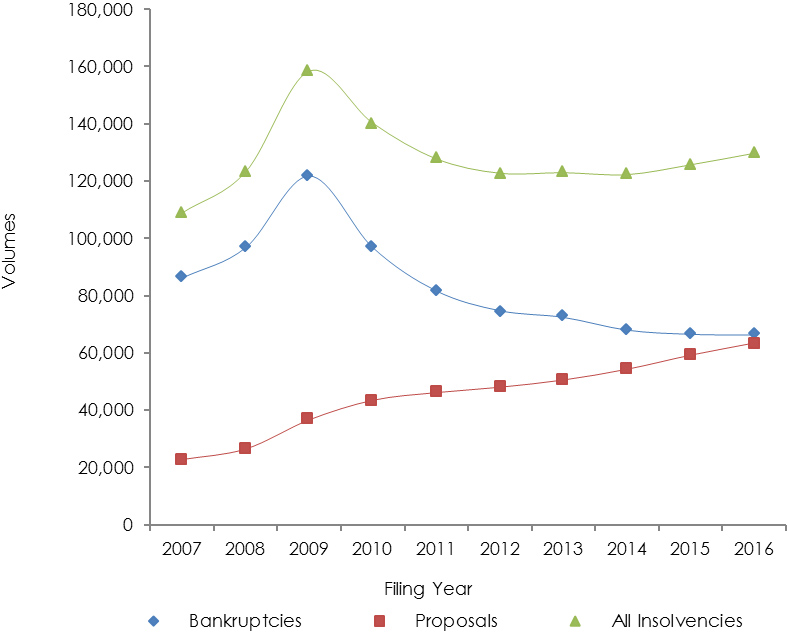
Source: Office of the Superintendent of Bankruptcy
In 2007, bankruptcies accounted for 79% of total insolvency volumes. This percentage decreased throughout the years, dropping to 51% in 2016. In contrast, the volume and percentage of proposals increased during this period, representing 49% of total insolvencies in 2016.
Consumer insolvency volumes
Consumer insolvency filings represent the majority of insolvency filings in Canada (97% in 2016) and are the trendsetter for total insolvency volumes. They increased by 2.4% per year, from 101,293 in 2007 to 125,878 in 2016, with a peak of 151,712 in 2009.
Consumer proposals increased proportionally and in volumes while consumer bankruptcies experienced the opposite (Figure 2).
Figure 2: Consumer Insolvency Volumes in Canada by Insolvency Type
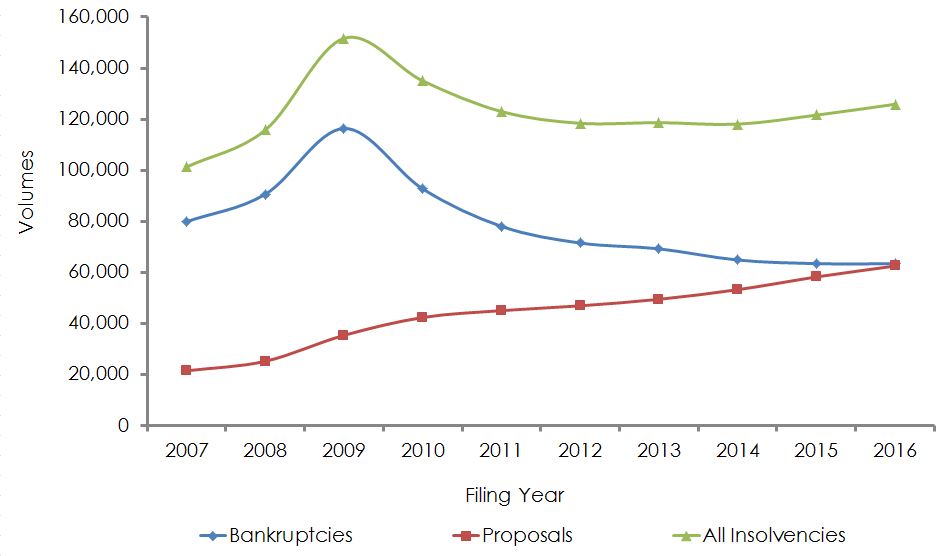
Source: Office of the Superintendent of Bankruptcy
Business insolvency volumes
Business insolvency volumes, a small portion of total insolvency volumes, decreased by 7.3% per year, from 7,612 in 2007 to 3,849 in 2016. Both business bankruptcies and business proposals decreased during this period, with proposals falling at a slower pace (Figure 3).
Figure 3: Business Insolvency Volumes in Canada by Insolvency Type
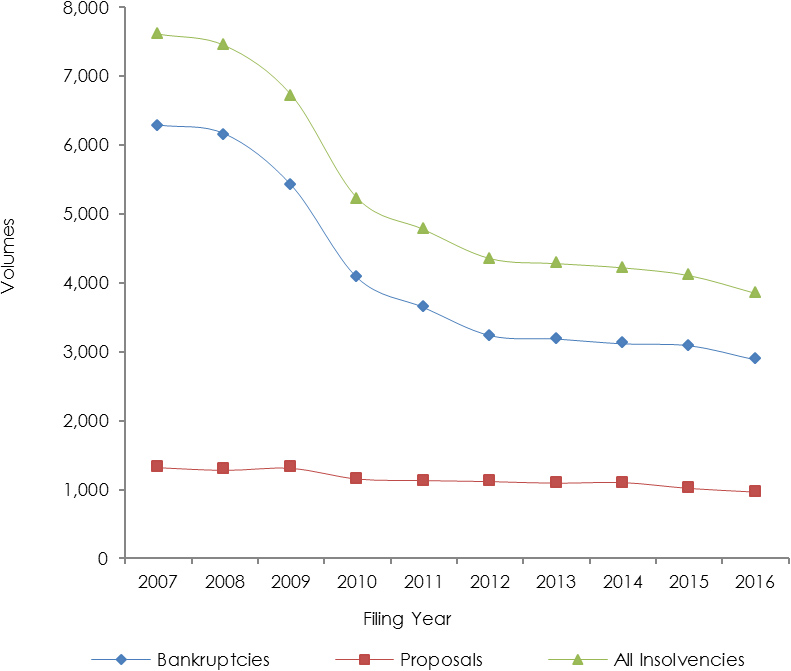
Source: Office of the Superintendent of Bankruptcy
Insolvency Rates
Insolvency rates are calculated as the number of insolvencies per thousand. They are calculated for consumers and businesses, overall, and for bankruptcies and proposals.
Consumer insolvency rates
About 4 out of 1,000 Canadian residents aged 18 years and older filed for consumer insolvency every year during the 2007–2016 period (Figure 4).
There was a noticeable increase in this number during the 2008–09 recession to around 6 and a gradual decrease afterwards to pre-recession levels.
The number of Canadian residents filing a consumer proposal gradually increased from 0.8 per thousand in 2007 to 2.2 per thousand in 2016. The reverse trend was observed for bankruptcies.
Figure 4: Consumer Insolvency Rates in Canada by Insolvency Type

Source: Office of the Superintendent of Bankruptcy
Business insolvency rates
The number of businesses filing for insolvency per thousand was on a downward trend during the 2007–2016 period (Figure 5).
It declined from around 3 businesses per thousand in 2007 to 1 business per thousand in 2016. The number of businesses filing for bankruptcy per thousand declined at a faster pace than the number of businesses filing a proposal per thousand.
Figure 5: Business Insolvency Rates in Canada by Insolvency Type
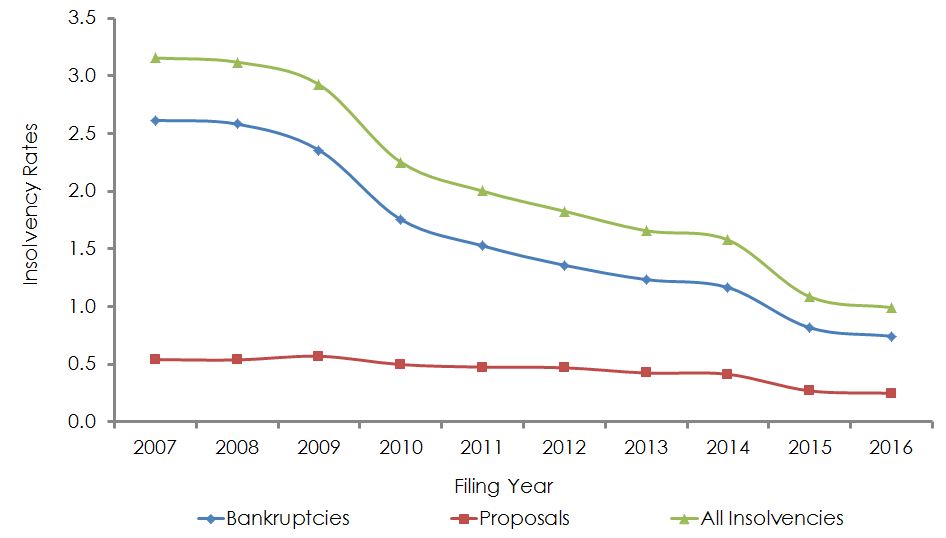
Source: Office of the Superintendent of Bankruptcy
Demographic Overviews
This section includes trends of insolvent consumers by age and gender; and trends of insolvent businesses by North American Industry Classification System.
Consumers
Age
The age of insolvent consumers is collected at the time of filing. For the trend analysis, insolvent consumers are grouped into four age groups: "18 to 24 years," "25 to 44 years," "45 to 64 years," and "65 years and older." Also considered in the analysis is a comparison of each age group's share of insolvent consumers to its share of the Canadian population aged 18 years and older.
Overall, age groups "25 to 44 years" and "45 to 64 years" account for 85.8% of all insolvent consumers, while their share of the Canadian population is about 70%.
18 to 24 years old
About 6,000 Canadian residents aged 18 to 24 filed for insolvency in 2007, a number that grew during the recession but gradually decreased to around 4,200 in 2016 (Figure 6).
Figure 6: Consumer Insolvency Volumes for Age Group 18 to 24 Years Old by Insolvency Type
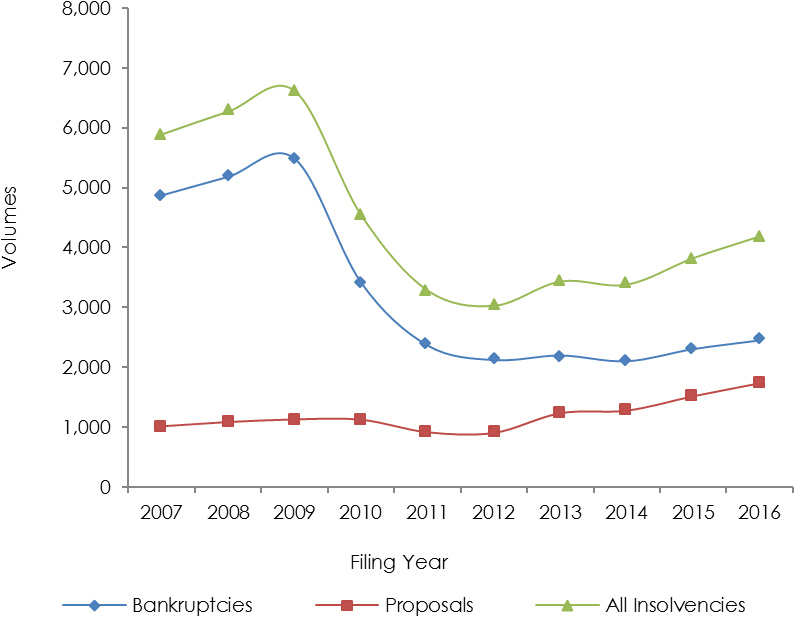
Source: Office of the Superintendent of Bankruptcy
Bankruptcy was by far the primary choice of insolvent Canadian residents in this age group in 2007, although the gap between bankruptcies and proposals grew smaller during the following years.
This age group's share of all insolvent consumers decreased from about 6% in 2007 to 3% in 2016 (Figure 7). However, its share of the Canadian population aged 18 years and older was steady at about 12%.
Figure 7: Age Group 18 to 24, Share of Population Versus Share of Insolvent Consumers
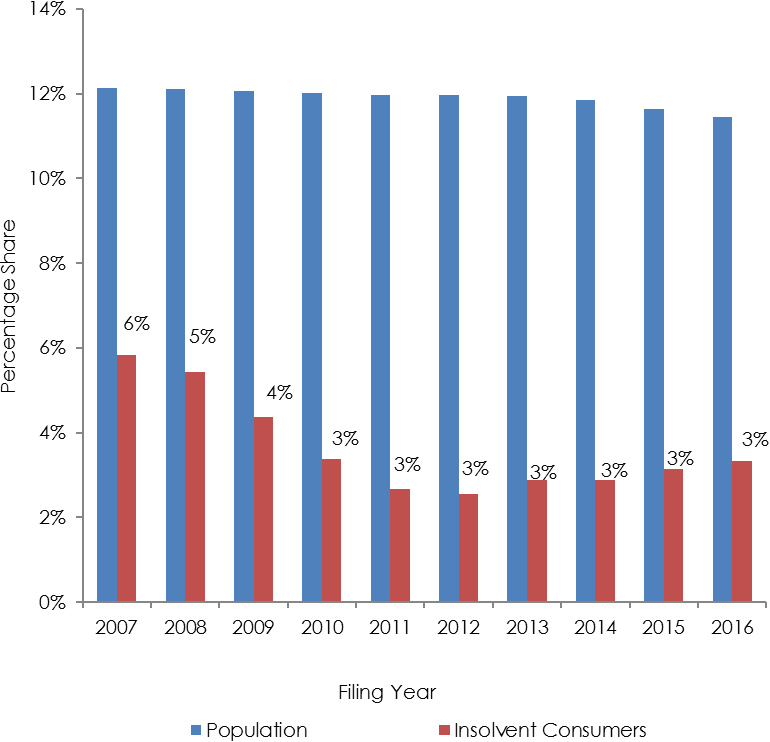
Source: Office of the Superintendent of Bankruptcy
CANSIM Table 051-0001
25 to 44 years old
About 53,000 Canadian residents aged 25 to 44 filed for insolvency in 2007, a number that grew during the recession but gradually decreased afterwards. It settled at around 57,000 in 2016, about 7.5% higher than in 2007 (Figure 8).
Bankruptcy was the primary choice of insolvent Canadian residents in this age group in 2007. However, by 2016, proposals were slightly more prevalent than bankruptcies.
Figure 8: Consumer Insolvency Volumes for Age Group 25 to 44 Years Old by Insolvency Type
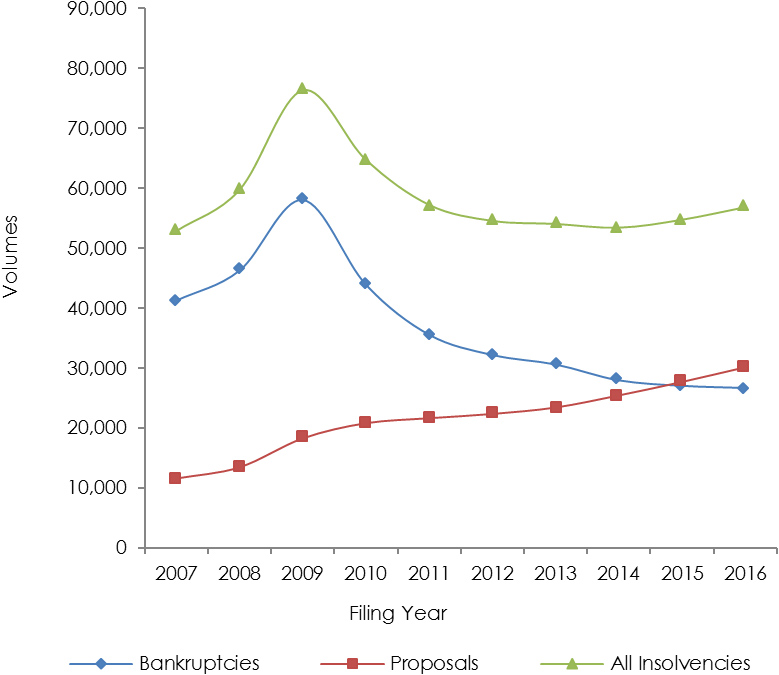
Source: Office of the Superintendent of Bankruptcy
This age group's share of all insolvent consumers decreased from 52% in 2007 to 45% in 2016 (Figure 9). Its share of the Canadian population aged 18 years and older was stable at about one third.
Figure 9: Age Group 25 to 44, Share of Population Versus Share of Insolvent Consumers

Source: Office of the Superintendent of Bankruptcy
CANSIM Table 051-0001
45 to 64 years old
About 36,000 Canadian residents aged 45 to 64 filed for insolvency in 2007, a number that grew during the recession and stayed flat at around 51,000 (Figure 10).
Bankruptcy was the primary choice of insolvent Canadian residents in this age group in 2007. However, by 2016, their choice was split in half between proposals and bankruptcies.
Figure 10: Consumer Insolvency Volumes for Age Group 45 to 64 Years Old by Insolvency Type
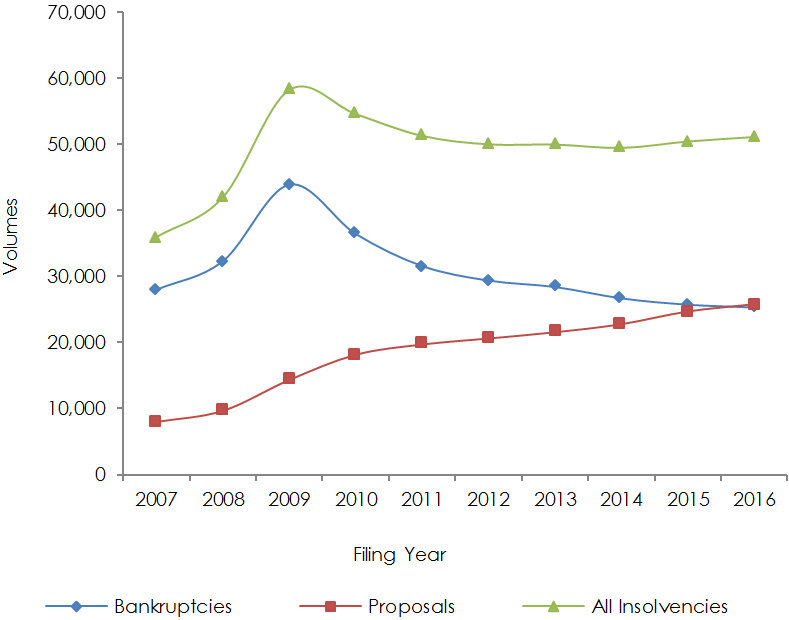
Source: Office of the Superintendent of Bankruptcy
This age group's share of all insolvent consumers increased from 36% in 2007 to 41% in 2016 (Figure 11). Its share of the Canadian population aged 18 years and older was stable at about one third.
Figure 11: Age Group 45 to 64, Share of Population Versus Share of Insolvent Consumers
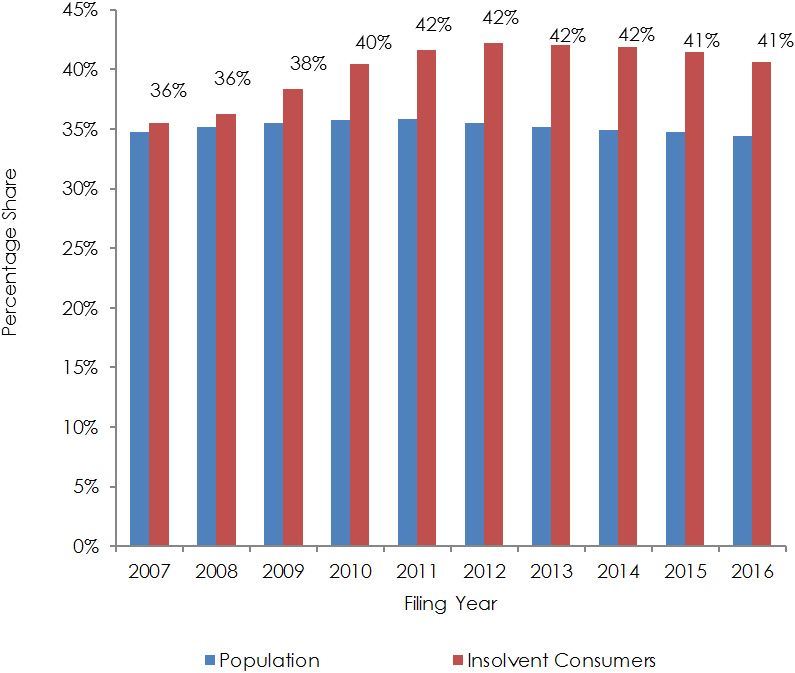
Source: Office of the Superintendent of Bankruptcy
CANSIM Table 051-0001
65 years and older
About 6,600 Canadian residents aged 65 and older filed for insolvency in 2007, a number that grew during the recession and reached 14,000 in 2016 (Figure 12).
Figure 12: Consumer Insolvency Volumes for Age Group 65 Years and Older by Insolvency Type
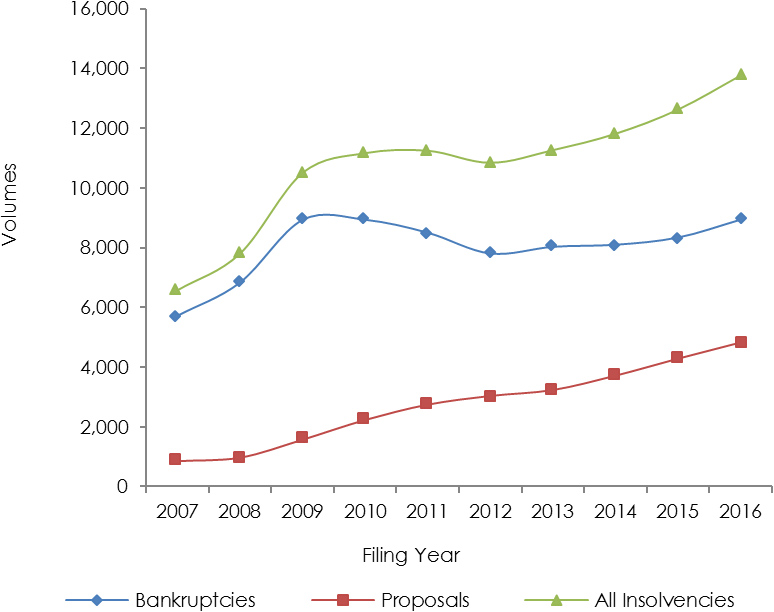
Source: Office of the Superintendent of Bankruptcy
Bankruptcy was by far the primary choice of insolvent Canadian residents in this age group in 2007. However, by 2016, the gap between bankruptcies and proposals grew somewhat smaller.
This age group's share of all insolvent consumers increased from 6% in 2007 to 11% in 2016 (Figure 13). Its share of the Canadian population aged 18 years and older also grew from about 17% in 2007 to 20% in 2016.
Figure 13: Age Group 65 Years and Older, Share of Population Versus Share of Insolvent Consumers
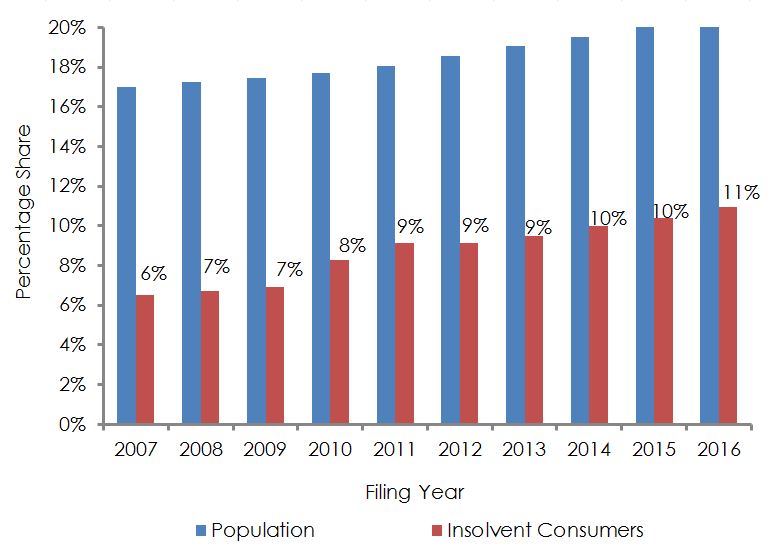
Source: Office of the Superintendent of Bankruptcy
CANSIM Table 051-0001
Gender
The distribution of insolvent consumers by gender was fairly stable over the 2007–2016 period. Males' share of the total (53% in 2016) was slightly higher than females (47% in 2016), while their share of the Canadian population was historically lower than females. It was about 49.6% in 2016 (Figure 14).
Figure 14: Gender Distribution of All Insolvent Consumers
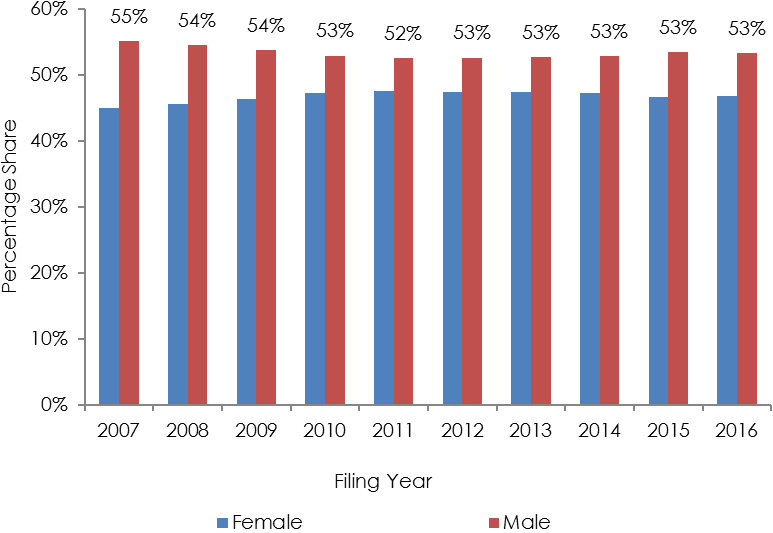
Source: Office of the Superintendent of Bankruptcy
The distributions of consumer bankruptcies and proposals by gender are included in Figures 15 and 16. They are very similar to the overall distribution. In 2016, males represented 53% of consumer bankruptcies and 53% of consumer proposals.
Figure 15: Gender Distribution of Consumers Who Filed a Bankruptcy
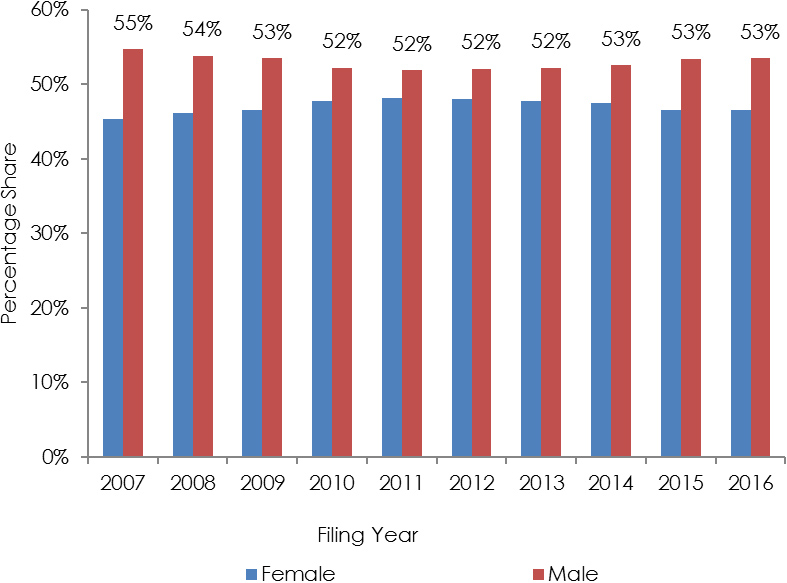
Source: Office of the Superintendent of Bankruptcy
Figure 16: Gender Distribution of Consumers Who Filed a Proposal
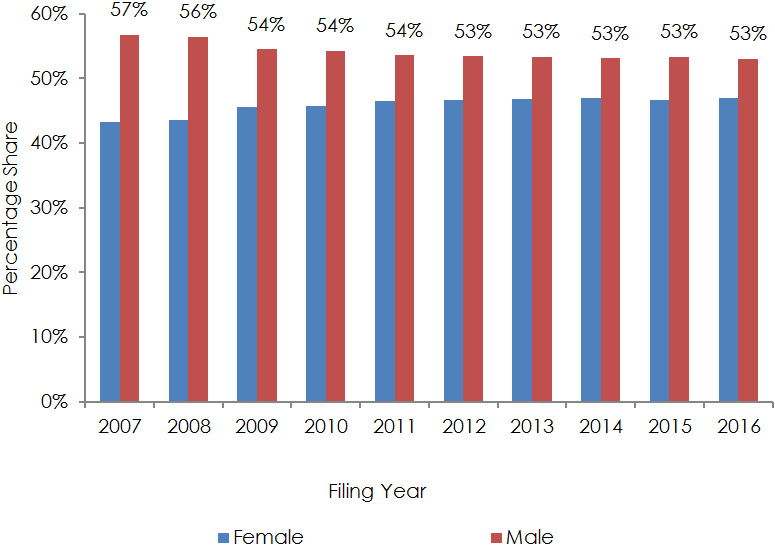
Source: Office of the Superintendent of Bankruptcy
Businesses
North American Industry Classification System Code
The North American Industry Classification System (NAICS) has twenty business sectors. This section focuses on the top five NAICS sectors based on the highest insolvency volumes. These top five sectors are Construction, Manufacturing, Retail Trade, Transportation and Warehousing, and Accommodation and Food Service. Together they represent about 60% of all business insolvencies throughout the period. The share of these sectors in all Canadian businesses decreased from 34% in 2007 to 25% in 2016.
Construction
The number of businesses that filed for insolvency in the construction sector was on a downward trend during the 2007–2016 period. The number dropped from close to 1,300 in 2007 to around 700 in 2016 (Figure 17).
Figure 17: Construction Sector, Business Insolvency Volumes by Insolvency Type
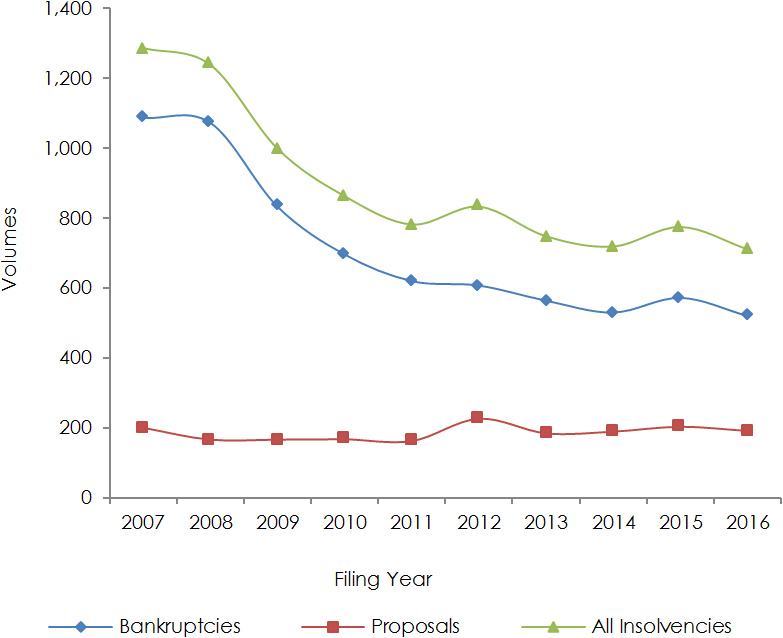
Source: Office of the Superintendent of Bankruptcy
This sector's share of insolvent Canadian businesses was stable at around 18% during the 2007–2016 period. Its share of all Canadian businesses is about 10% (Figure 18).
Figure 18: Construction Sector, Share of Insolvent Businesses Versus Share of Canadian Businesses
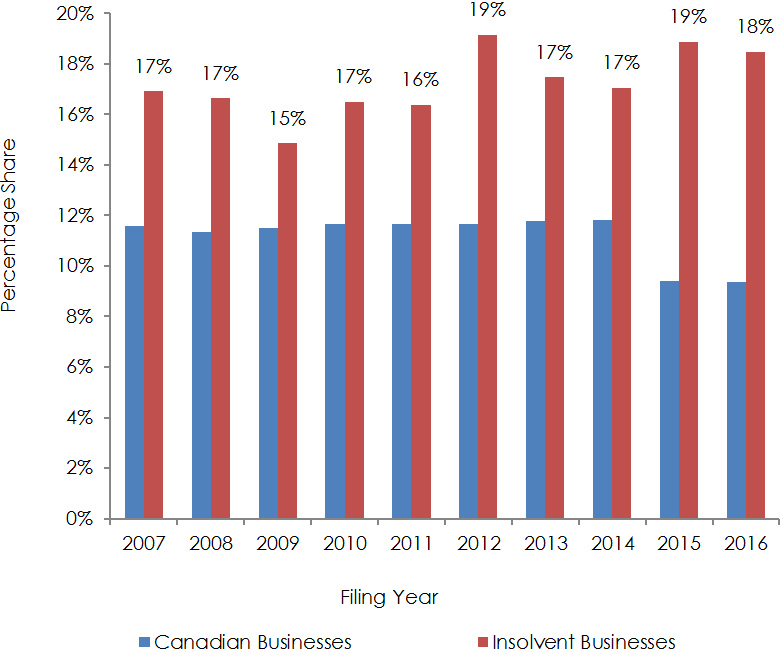
Source: Office of the Superintendent of Bankruptcy
Statistics Canada
Manufacturing
The number of businesses that filed for insolvency in the manufacturing sector was on a downward trend during the 2007–2016 period. The number dropped from close to 800 in 2007 to around 300 in 2016 (Figure 19).
Figure 19: Manufacturing Sector, Business Insolvency Volumes by Insolvency Type
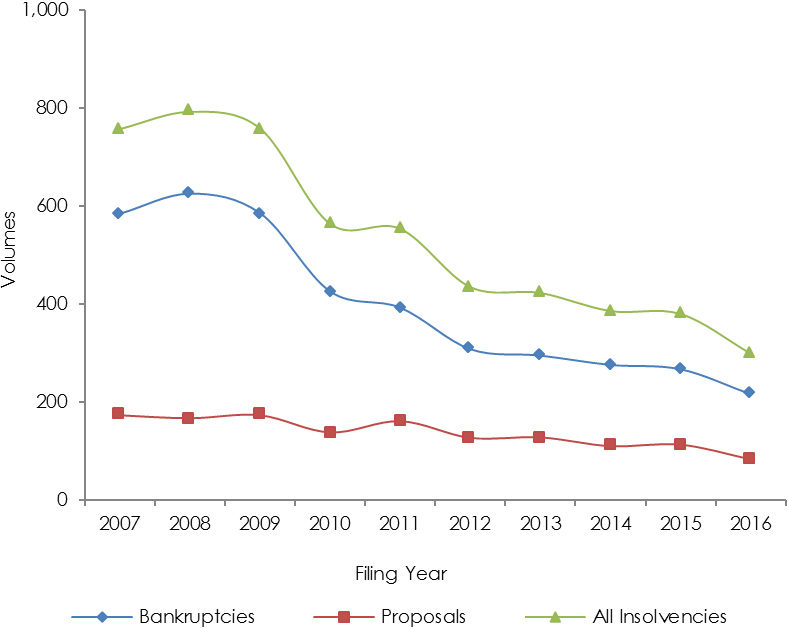
Source: Office of the Superintendent of Bankruptcy
This sector's share of insolvent Canadian businesses increased during the recession but ended the period at 8%, almost 2 percentage points lower than its starting level of 10%. Its share of all Canadian businesses hovers around 3% (Figure 20).
Figure 20: Manufacturing Sector, Share of Insolvent Businesses Versus Share of Canadian Businesses

Source: Office of the Superintendent of Bankruptcy, Statistics Canada
Retail Trade
The number of businesses that filed for insolvency in the retail trade sector was on a downward trend during the 2007–2016 period. The number dropped from close to 1,100 in 2007 to around 450 in 2016 (Figure 21).
Figure 21: Retail Trade Sector, Business Insolvency Volumes by Insolvency Type

Source: Office of the Superintendent of Bankruptcy, Statistics Canada
This sector's share of insolvent Canadian businesses dropped from 14% in 2007 to 12% in 2016. Its share of all Canadian businesses decreased to around 6% in 2016 (Figure 22).
Figure 22: Retail Trade Sector, Share of Insolvent Businesses Versus Share of Canadian Businesses
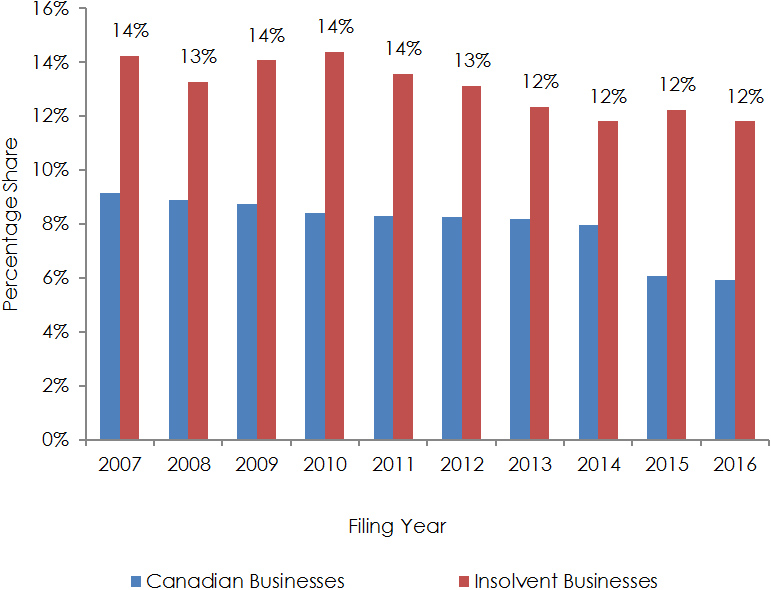
Source: Office of the Superintendent of Bankruptcy, Statistics Canada
Transportation and Warehousing
The number of businesses that filed for insolvency in the transportation and warehousing sector increased during the recession and dropped significantly afterwards to settle around 220 (Figure 23).
Figure 23: Transportation and Warehousing Sector, Business Insolvency Volumes by Insolvency Type
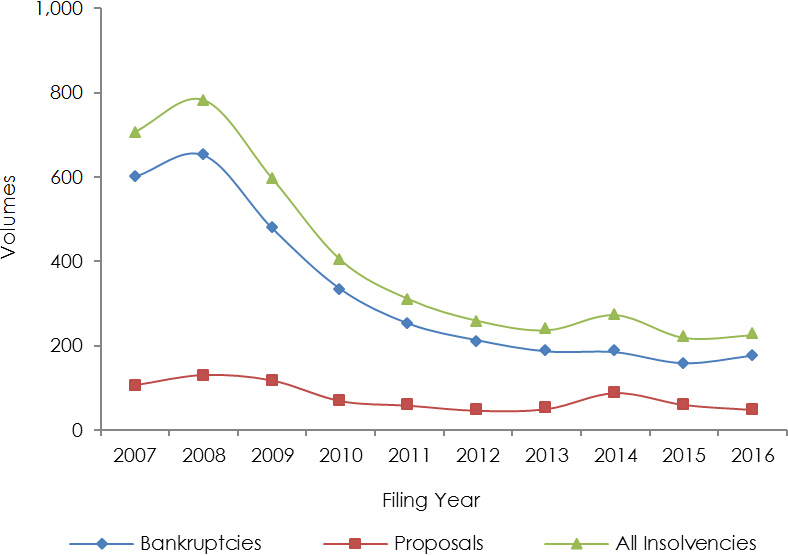
Source: Office of the Superintendent of Bankruptcy
This sector's share of insolvent Canadian businesses increased during the recession from 9% to 11% and dropped to 6% in 2016. Its share of all Canadian businesses hovers around 5% (Figure 24).
Figure 24: Transportation and Warehousing Sector, Share of Insolvent Businesses Versus Share of Canadian Businesses
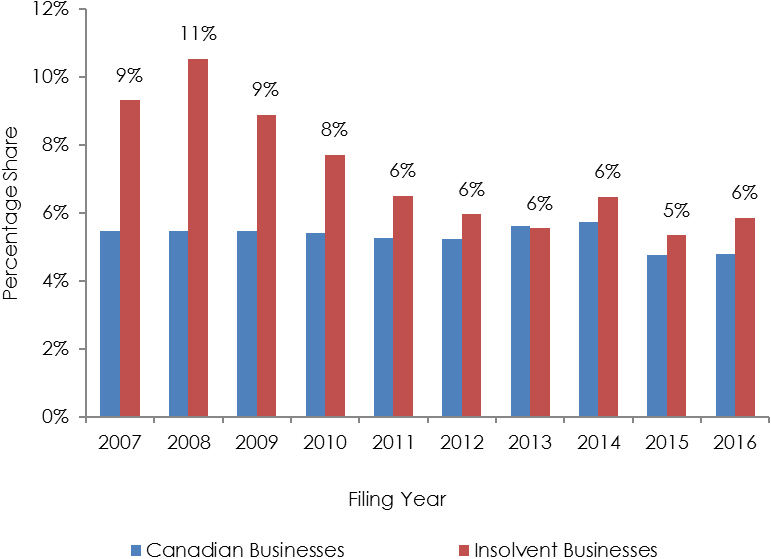
Source: Office of the Superintendent of Bankruptcy, Statistics Canada
Accommodation and Food Services
The number of businesses that filed for insolvency in the accommodation and food services sector was on a downward trend during the 2007–2016 period. The number dropped from close to 900 in 2007 to around 640 in 2010 and stayed flat afterwards (Figure 25).
Figure 25: Accommodation and Food Services Sector, Business Insolvency Volumes by Insolvency Type
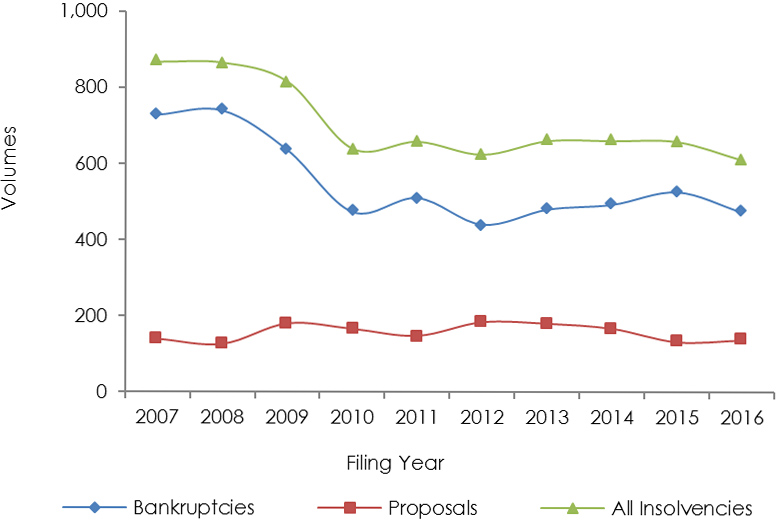
Source: Office of the Superintendent of Bankruptcy
This sector's share of total insolvent Canadian businesses increased from 11% in 2007 to 16% in 2016. Its share of all Canadian businesses hovers around 3% to 4% (Figure 26).
Figure 26: Accommodation and Food Services Sector, Share of Insolvent Businesses Versus Share of Canadian Businesses

Source: Office of the Superintendent of Bankruptcy, Statistics Canada
Data tables that were used to generate the graphs above are included in Annex D.
Financial Overview
This section presents trends of assets and liabilities declared at the time of filing of insolvent consumers and businesses. It also presents trends of the assets/liabilities deficit position of insolvent consumers and businesses.
Assets and liabilities of insolvent consumers
Overall, declared assets by insolvent consumers increased during the 2007–2016 period, from $4.3 billion in 2007 to $10.8 billion in 2016. Declared liabilities followed a similar trend, increasing from $7.5 billion to $15 billion, with a peak of $16.7 billion in 2009 (Figure 27).
The assets/liabilities deficit position of insolvent consumers increased during the 2008–09 recession reaching $6 billion, but decreased afterwards to pre-recession levels.
Figure 27: Assets and Liabilities of Insolvent Consumers
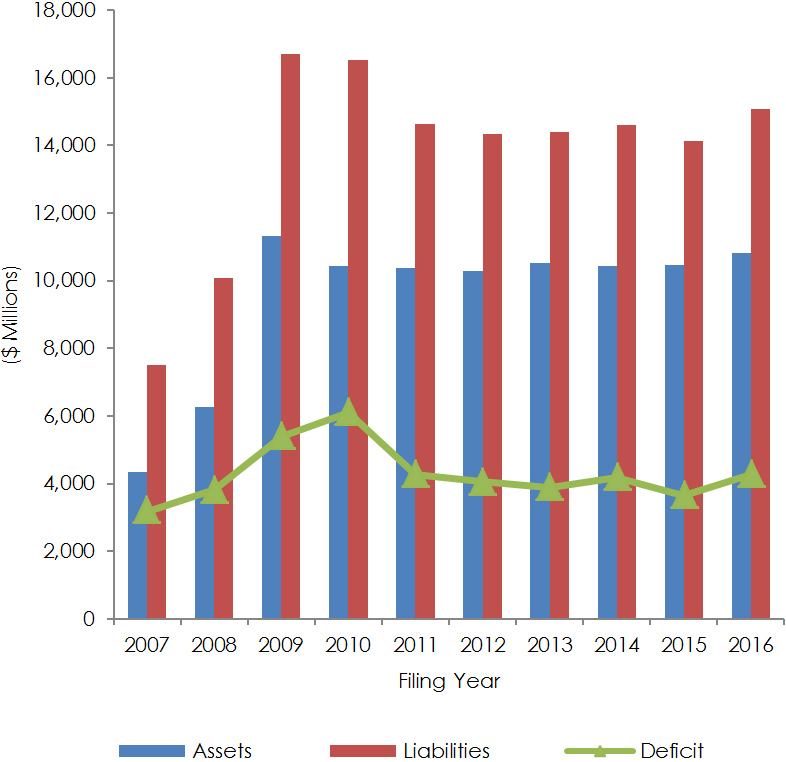
Source: Office of the Superintendent of Bankruptcy
For consumers who filed a bankruptcy, declared assets and liabilities followed a similar trend as overall consumers (Figure 28). Their assets/liabilities deficit position increased during the 2009 recession reaching $6 billion and decreased afterwards to $4 billion, about $1 billion higher than in 2007.
Figure 28: Assets and Liabilities of Insolvent Consumers Who Filed a Bankruptcy
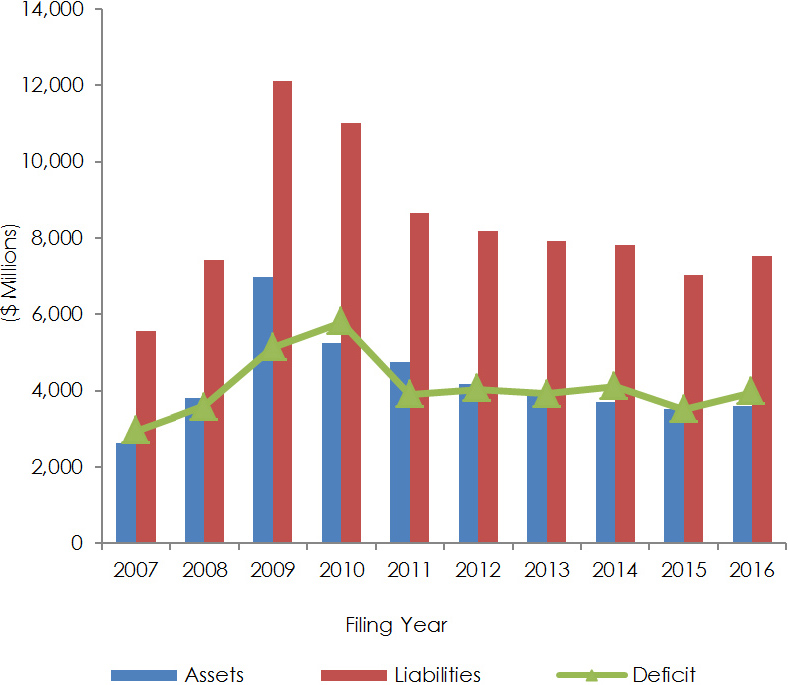
Source: Office of the Superintendent of Bankruptcy
For consumers who filed a proposal, declared assets and liabilities steadily increased during this period (Figure 29). Declared assets increased from $1.7 billion in 2007 to $7.2 billion in 2016, while declared liabilities increased from $1.9 billion in 2007 to $7.5 billion in 2016. Their assets/liabilities deficit position was very small throughout the period, compared to consumers who filed a bankruptcy.
Figure 29: Assets and Liabilities of Insolvent Consumers Who Filed a Proposal
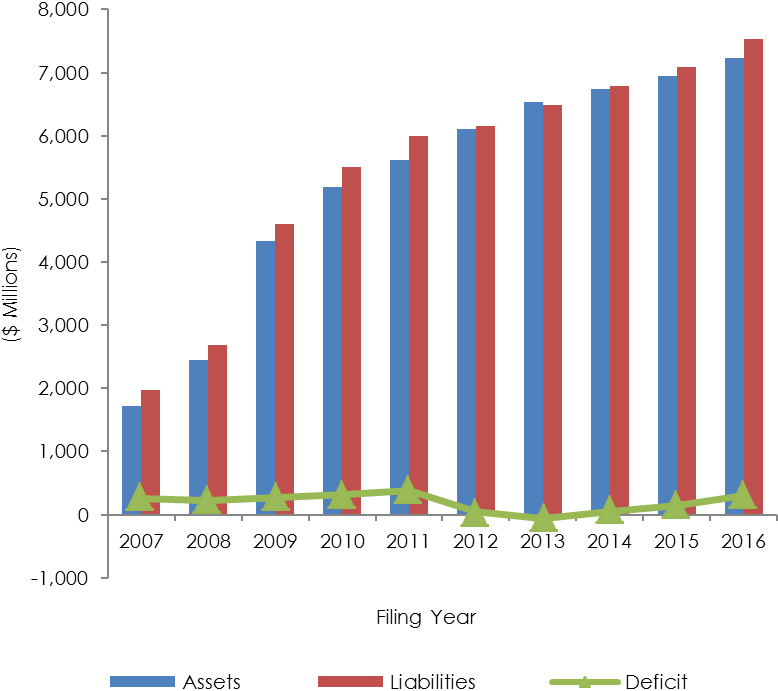
Source: Office of the Superintendent of Bankruptcy
Assets and liabilities of insolvent businesses
Overall, trends of declared assets and liabilities by insolvent businesses are more volatile. A small number of large business insolvency filings have a disproportionate effect on overall values and may cause significant swings from year to year. This is exemplified in the $17 billion liabilities figure of 2016, originating from a small number of business filings.
In aggregate, declared assets by insolvent businesses fluctuated between $681 million and $2.1 billion during the 2007–2016 period. Excluding 2016, declared liabilities decreased after the 2008–09 recession and remained somewhat flat at around $5 billion. The large value of liabilities compared to assets resulted in large assets/liabilities deficits (Figure 30).
Figure 30: Assets and Liabilities of Insolvent Businesses

Source: Office of the Superintendent of Bankruptcy
* A small number of business filings account for this jump.
In aggregate, declared assets by insolvent businesses that filed a bankruptcy were much smaller than declared liabilities, which resulted in large assets/liabilities deficits. Declared assets fluctuated between $478 million and $1.8 billion. Excluding 2016, declared liabilities decreased after the 2008–09 recession to around $3 billion in 2012 and regained a slight upward trend during the 2013–2015 period (Figure 31).
Figure 31: Assets and Liabilities of Insolvent Businesses that Filed a Bankruptcy

Source: Office of the Superintendent of Bankruptcy
* A small number of business filings account for this jump.
In aggregate, declared assets by insolvent businesses that filed a proposal were also much smaller than declared liabilities, which resulted in large assets/liabilities deficits. They fluctuated between $103 million and $320 million. Declared liabilities were flat at around $1.4 billion with the exception of 2007 and 2014 (Figure 32).
Figure 32: Assets and Liabilities of Insolvent Businesses that Filed a Proposal
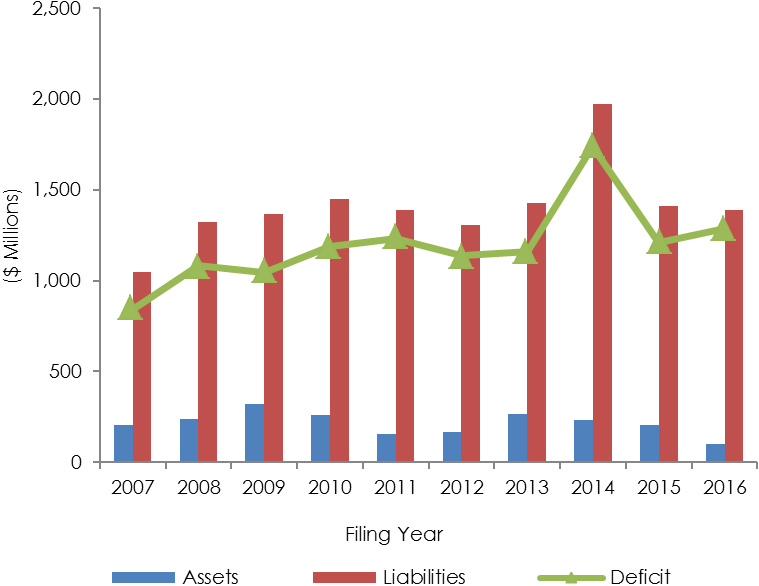
Source: Office of the Superintendent of Bankruptcy
Data tables that were used to generate the graphs above are included in Annex E.
Annex A: Consumer and Business Insolvency Volumes by Province and Territory
Consumer Volumes
Figure 33: Newfoundland and Labrador
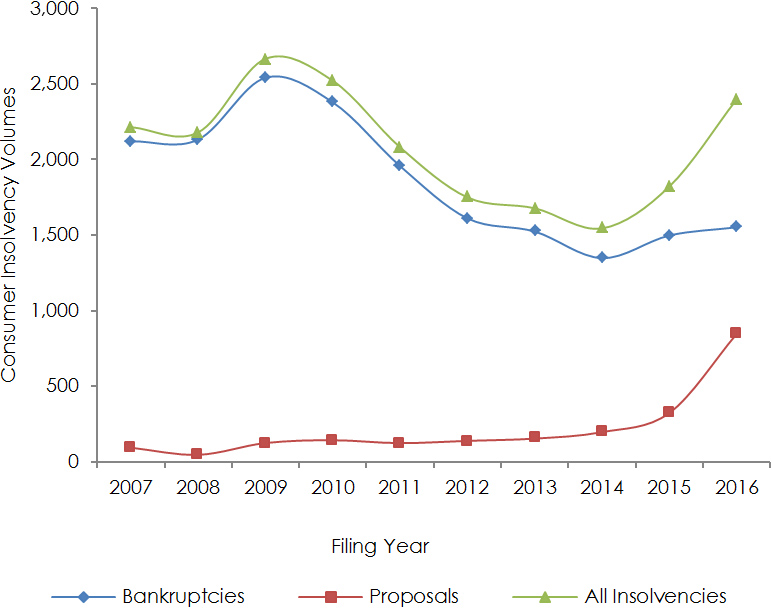
Source: Office of the Superintendent of Bankruptcy
Figure 34: Prince Edward Island
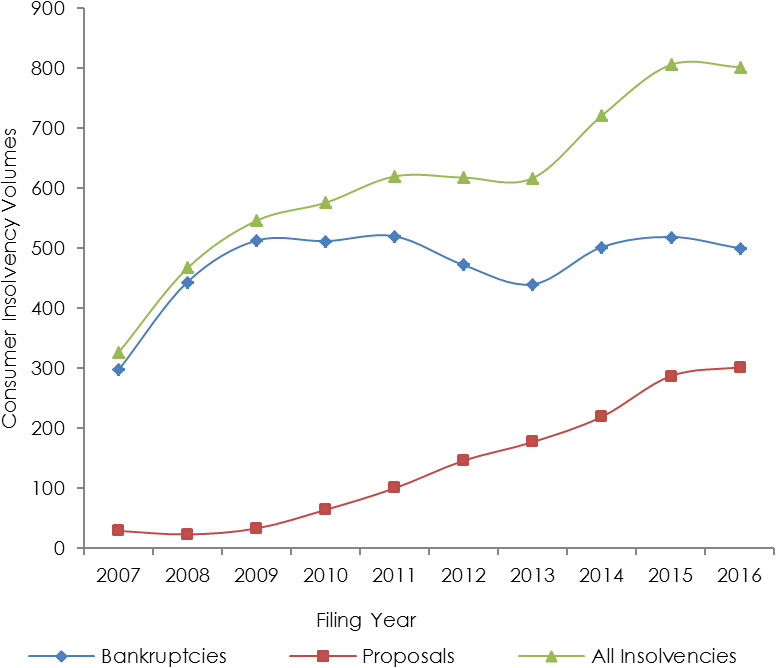
Source: Office of the Superintendent of Bankruptcy
Figure 35: Nova Scotia
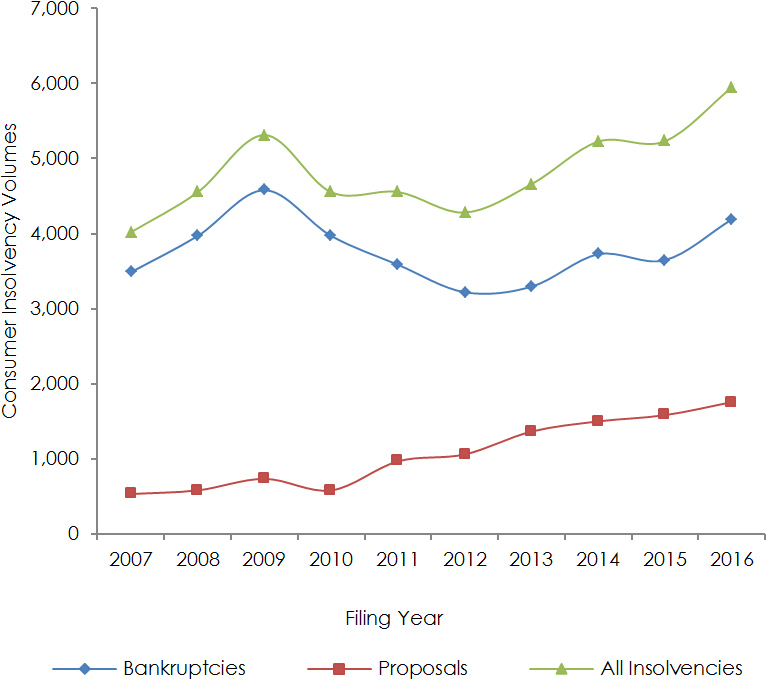
Source: Office of the Superintendent of Bankruptcy
Figure 36: New Brunswick
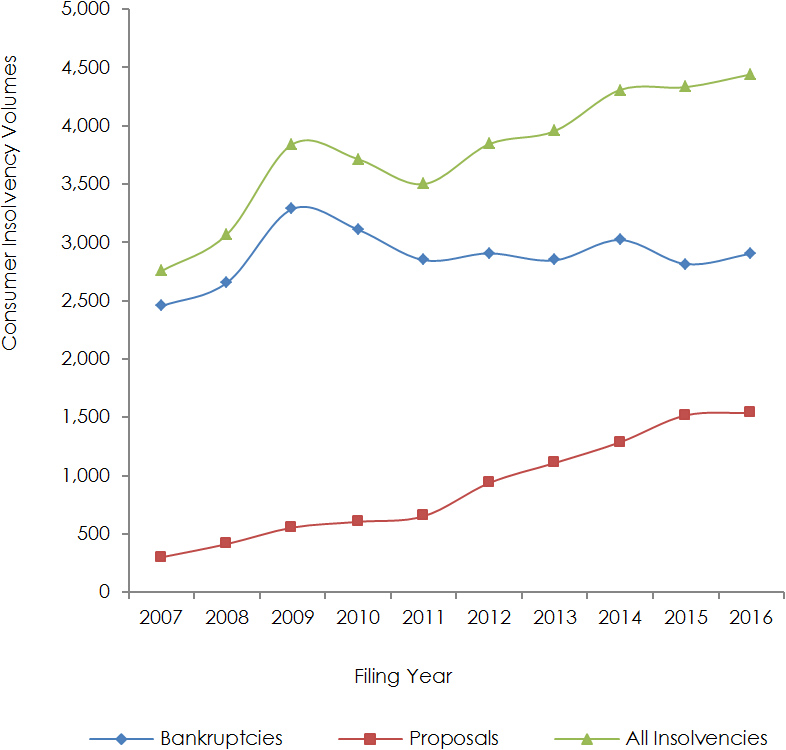
Source: Office of the Superintendent of Bankruptcy
Figure 37: Quebec
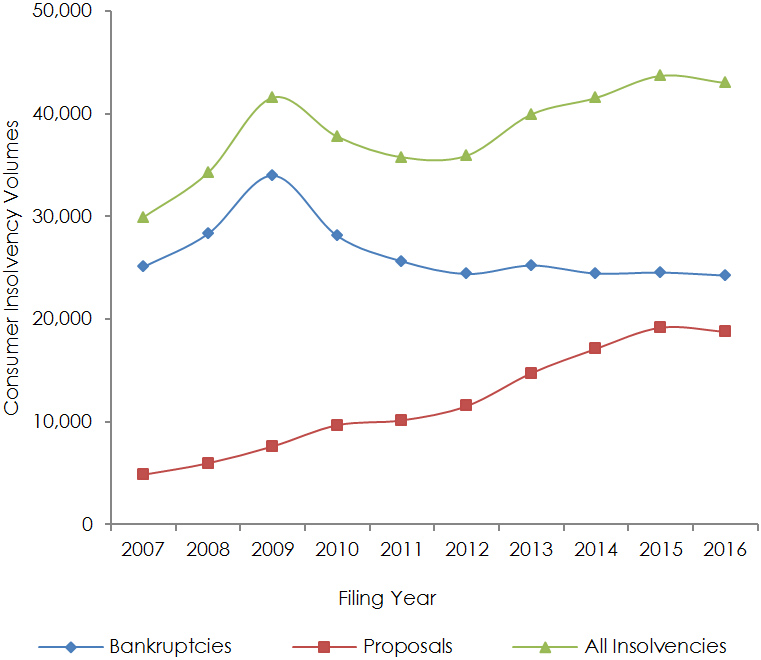
Source: Office of the Superintendent of Bankruptcy
Figure 38: Ontario
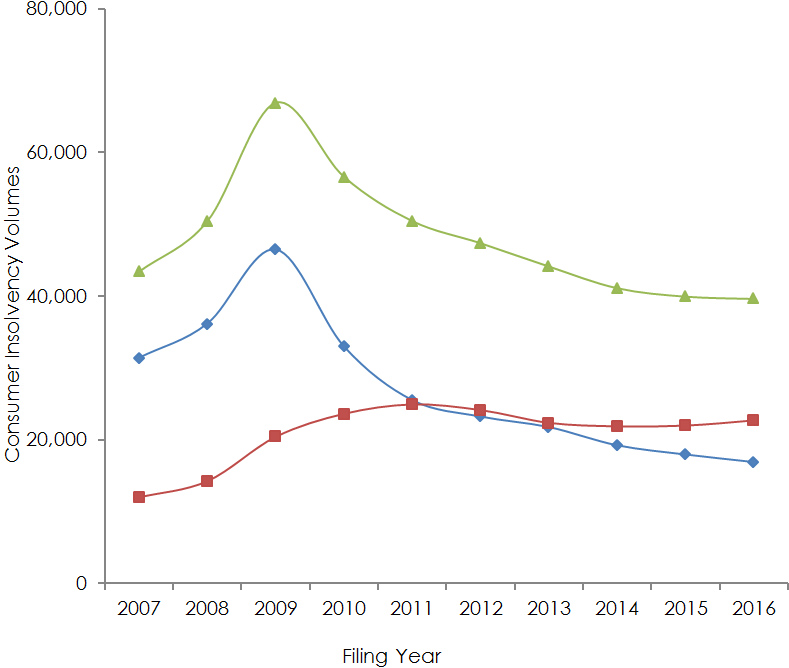
Source: Office of the Superintendent of Bankruptcy
Figure 39: Manitoba
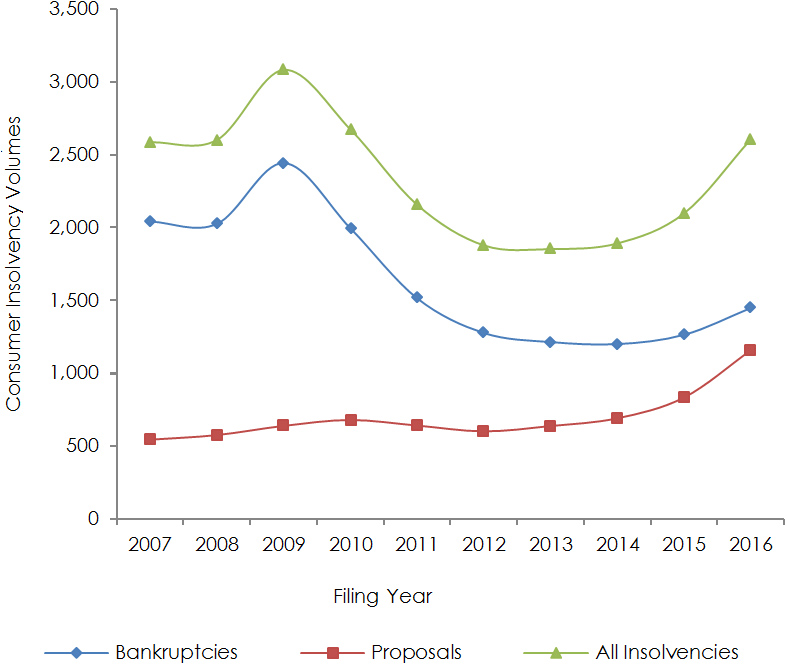
Source: Office of the Superintendent of Bankruptcy
Figure 40: Saskatchewan
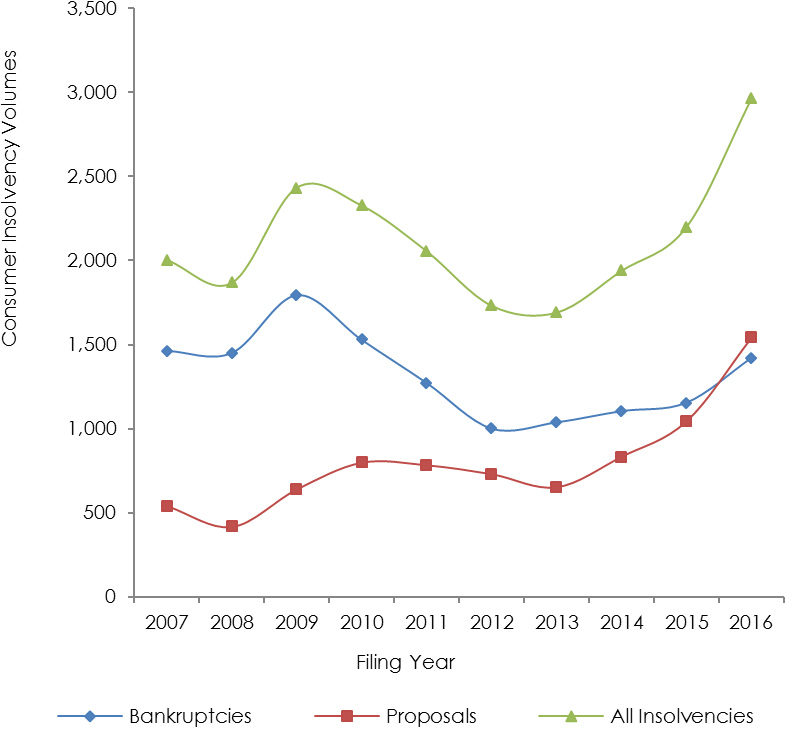
Source: Office of the Superintendent of Bankruptcy
Figure 41: Alberta

Source: Office of the Superintendent of Bankruptcy
Figure 42: British Columbia

Source: Office of the Superintendent of Bankruptcy
Figure 43: Northwest Territories

Source: Office of the Superintendent of Bankruptcy
Figure 44: Yukon
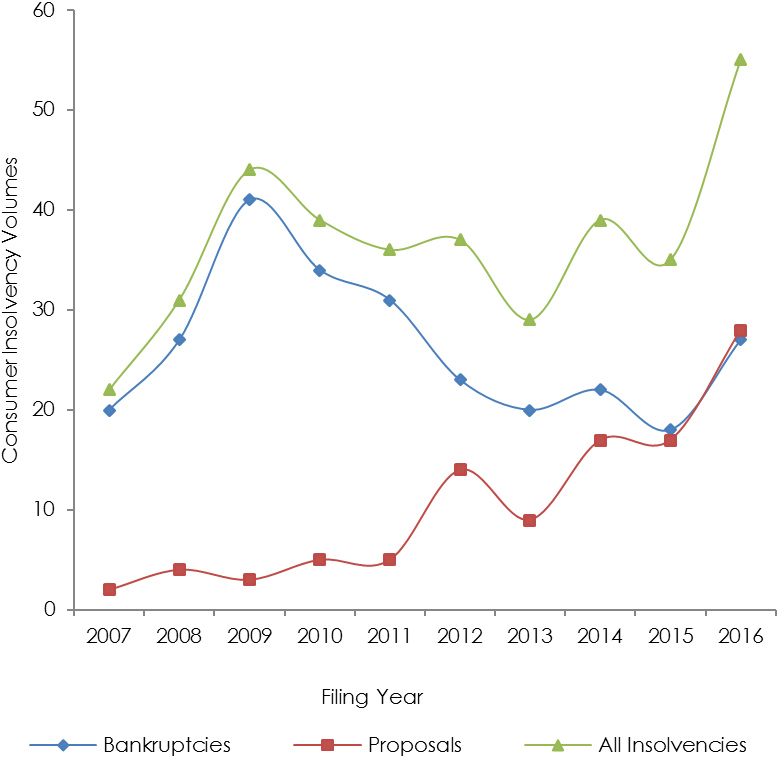
Source: Office of the Superintendent of Bankruptcy
Figure 45: Nunavut

Source: Office of the Superintendent of Bankruptcy
Business Volumes
Figure 46: Newfoundland and Labrador
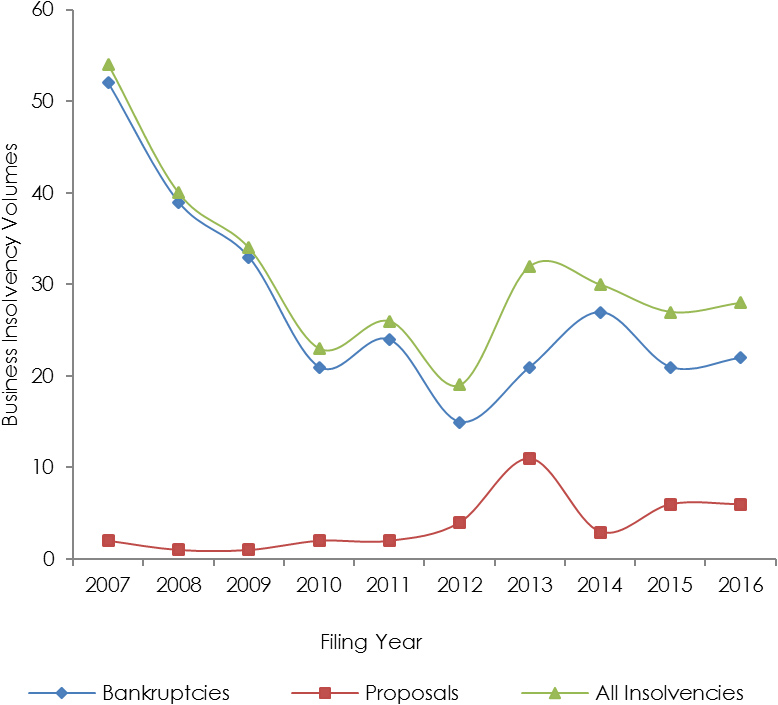
Source: Office of the Superintendent of Bankruptcy
Figure 47: Prince Edward Island
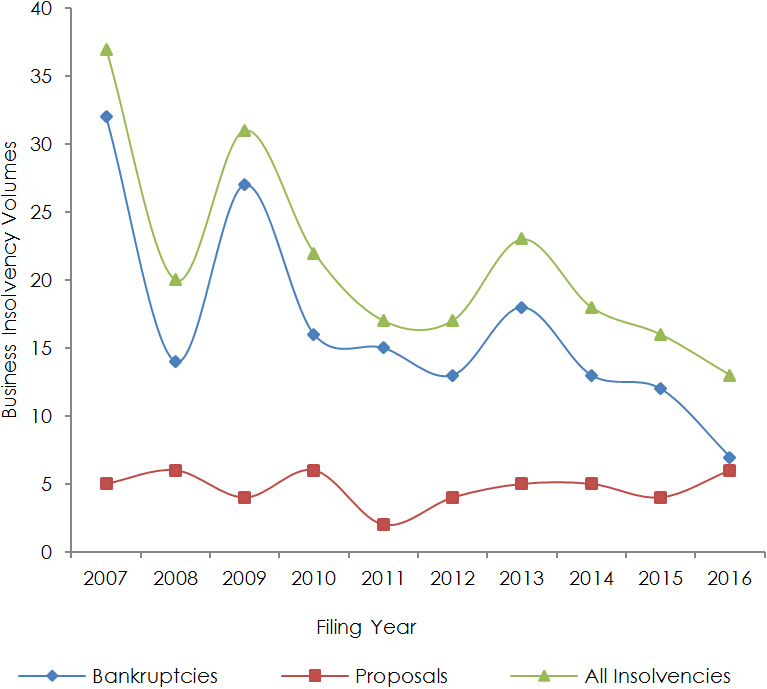
Source: Office of the Superintendent of Bankruptcy
Figure 48: Nova Scotia
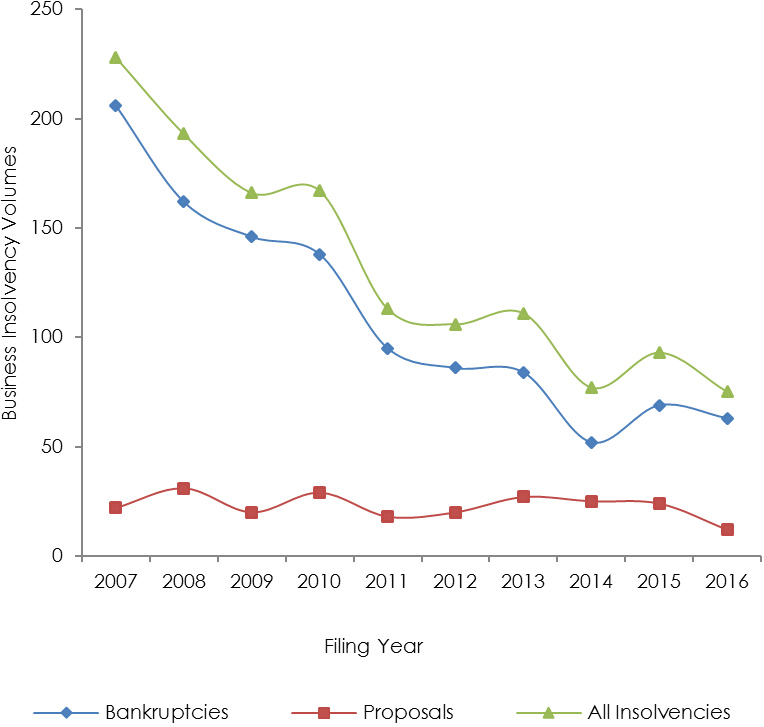
Source: Office of the Superintendent of Bankruptcy
Figure 49: New Brunswick
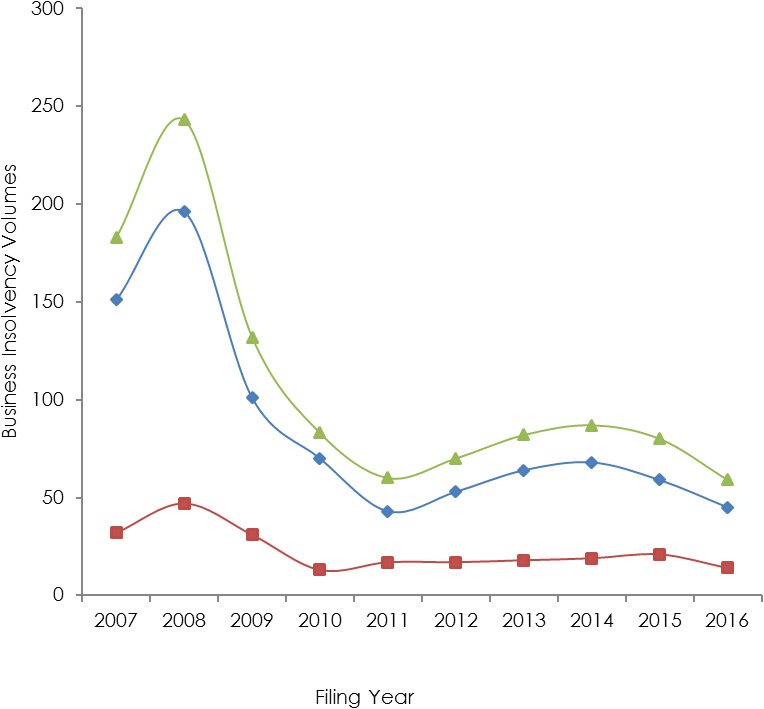
Source: Office of the Superintendent of Bankruptcy
Figure 50: Quebec
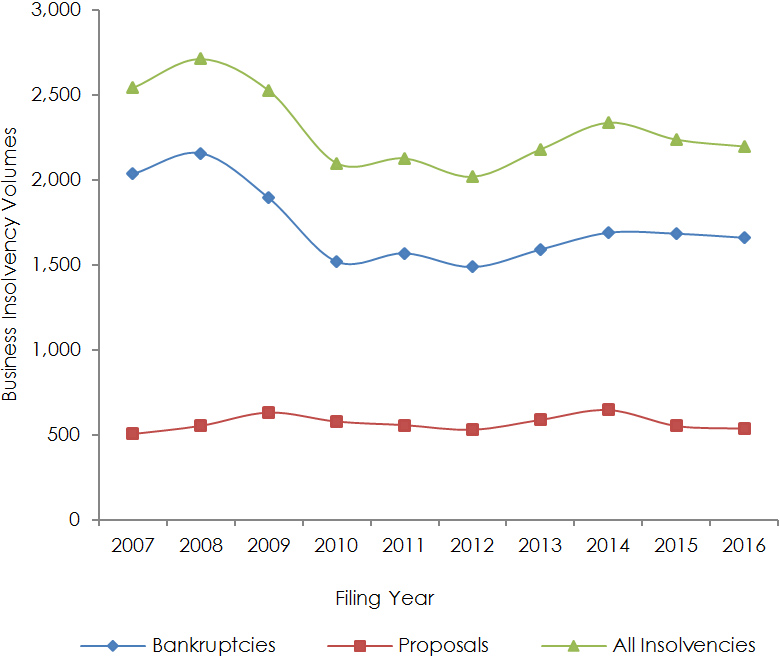
Source: Office of the Superintendent of Bankruptcy
Figure 51: Ontario
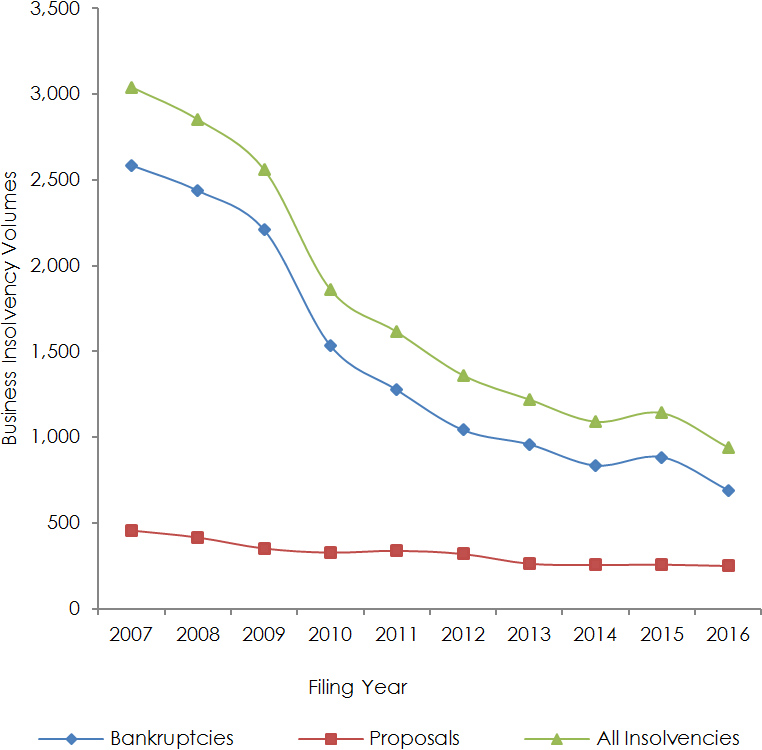
Source: Office of the Superintendent of Bankruptcy
Figure 52: Manitoba
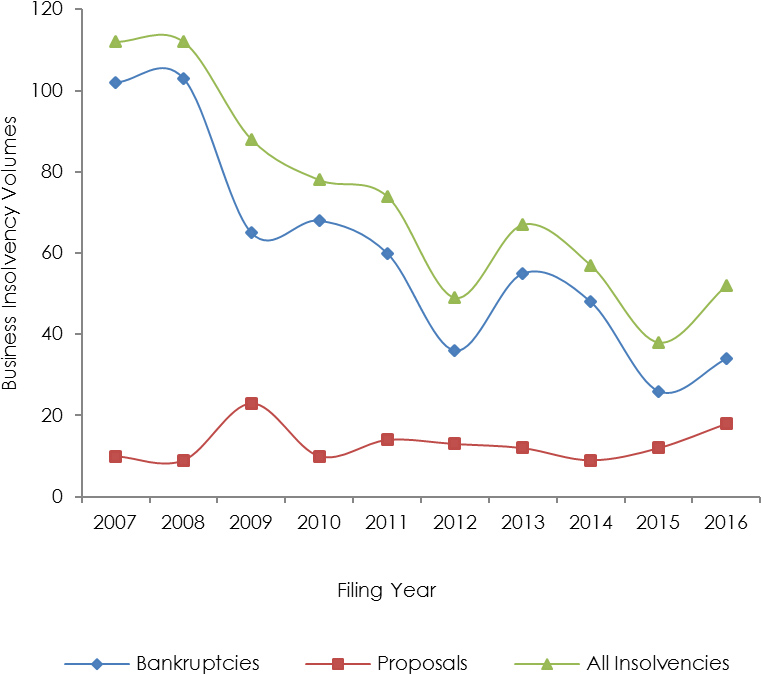
Source: Office of the Superintendent of Bankruptcy
Figure 53: Saskatchewan

Source: Office of the Superintendent of Bankruptcy
Figure 54: Alberta
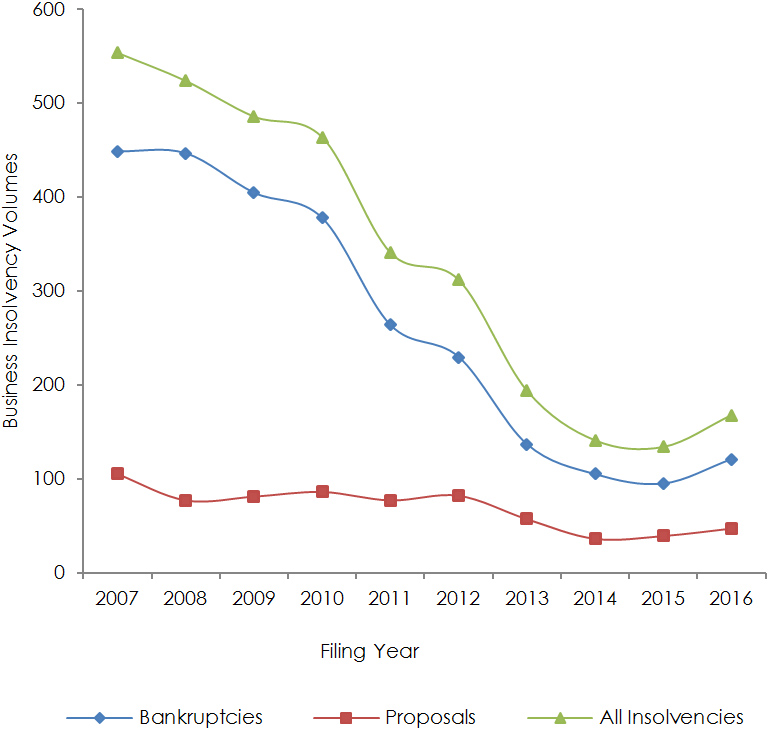
Source: Office of the Superintendent of Bankruptcy
Figure 55: British Columbia
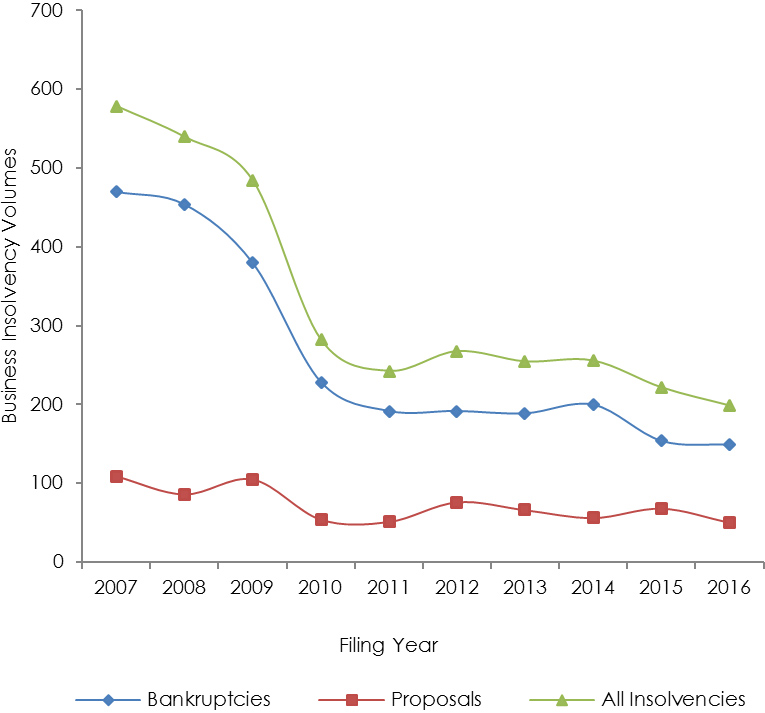
Source: Office of the Superintendent of Bankruptcy
Figure 56: Northwest Territories

Source: Office of the Superintendent of Bankruptcy
Figure 57: Yukon
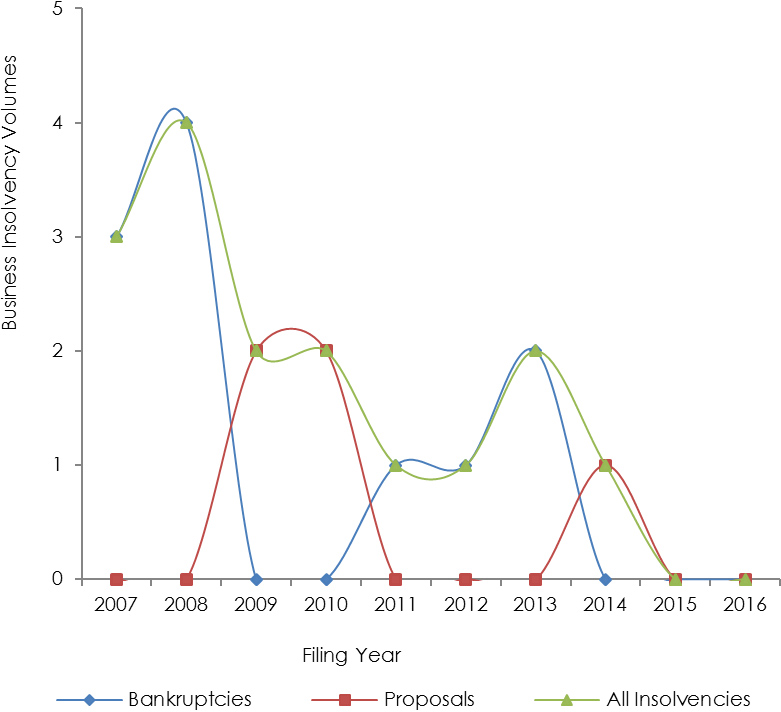
Source: Office of the Superintendent of Bankruptcy
Figure 58: Nunavut
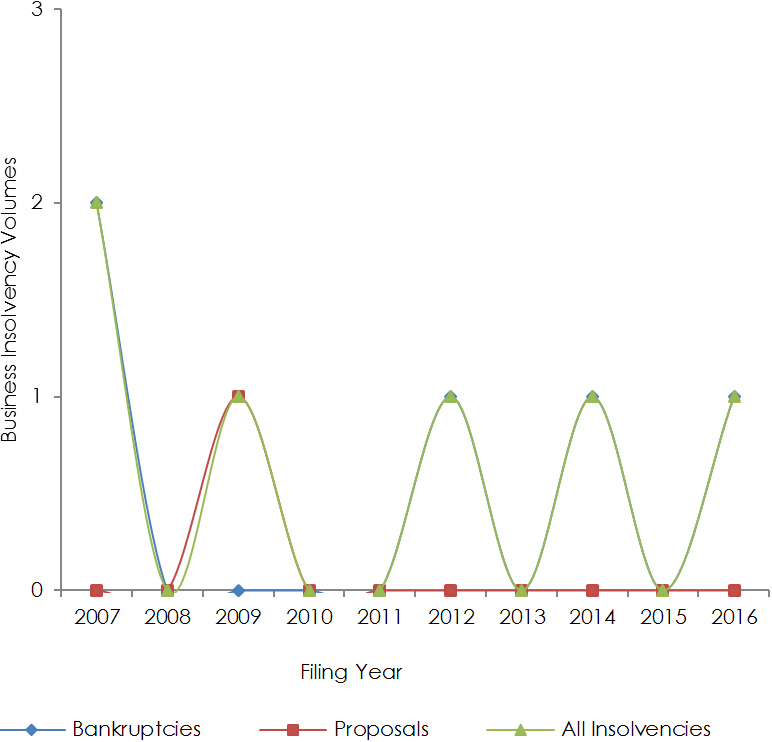
Source: Office of the Superintendent of Bankruptcy
Annex B – Consumer and Business Insolvency Rates by Province and Territory
Consumer Insolvency Rates
Figure 59: Newfoundland and Labrador
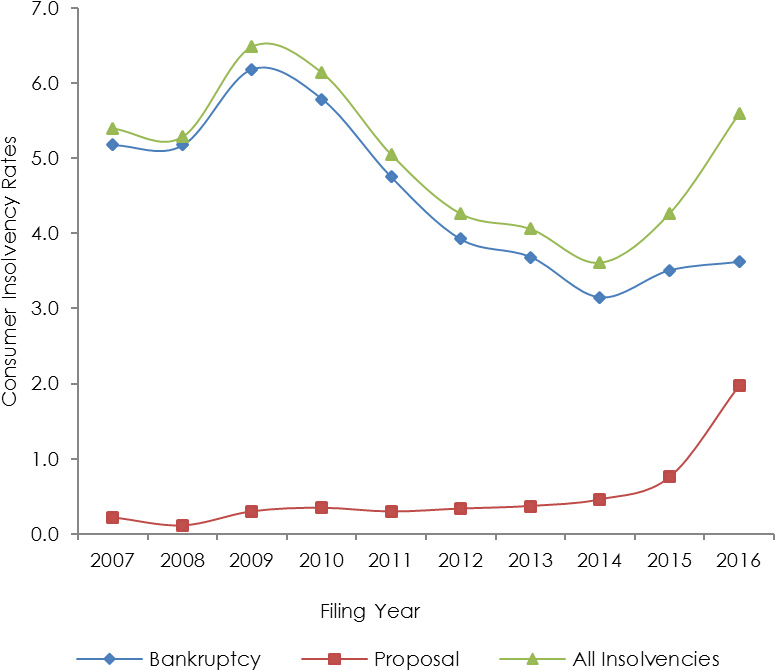
Source: Office of the Superintendent of Bankruptcy
Figure 60: Prince Edward Island

Source: Office of the Superintendent of Bankruptcy
Figure 61: Nova Scotia
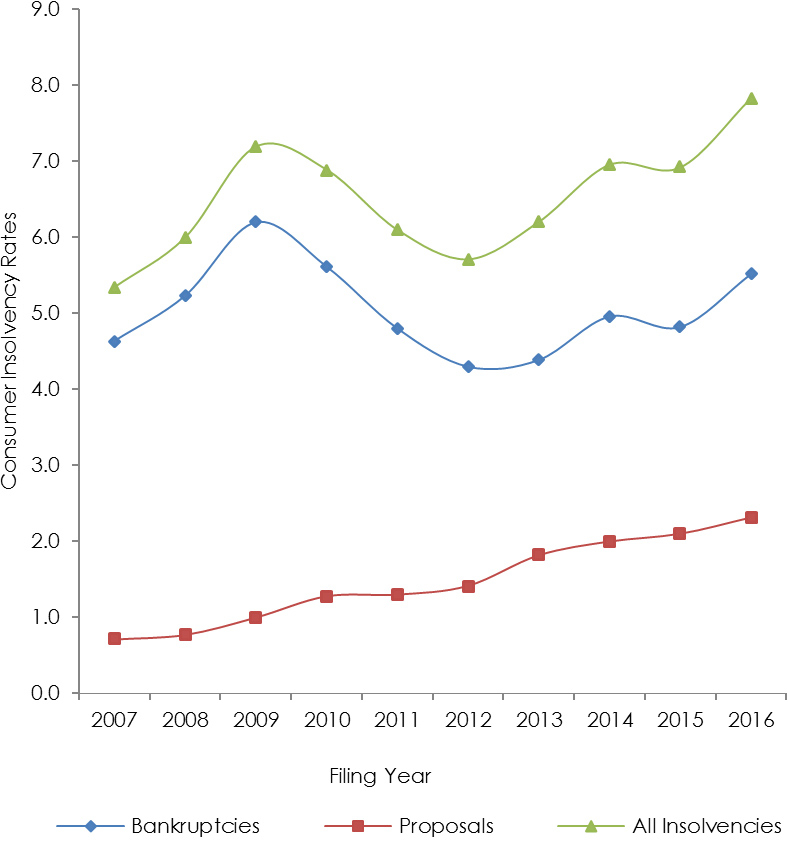
Source: Office of the Superintendent of Bankruptcy
Figure 62: New Brunswick
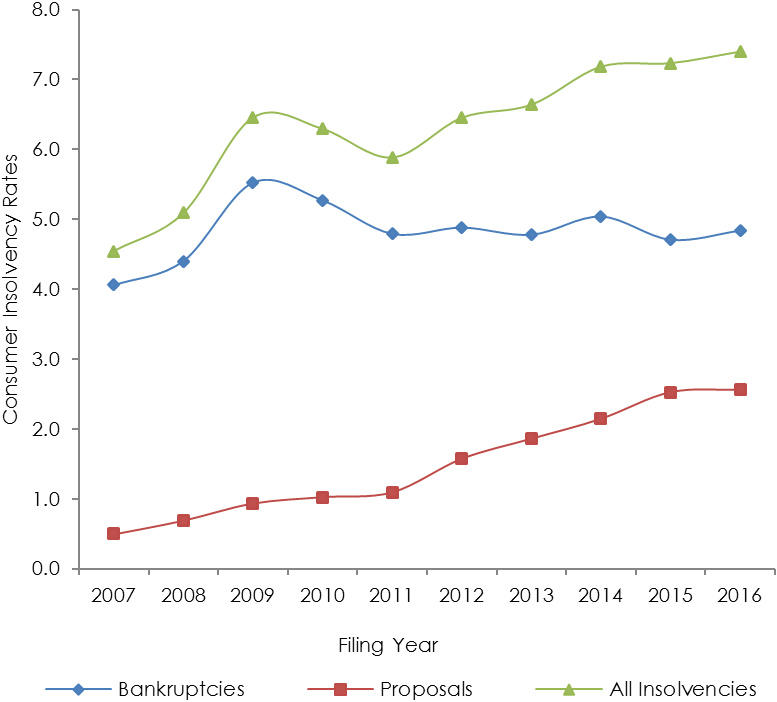
Source: Office of the Superintendent of Bankruptcy
Figure 63: Quebec

Source: Office of the Superintendent of Bankruptcy
Figure 64: Ontario
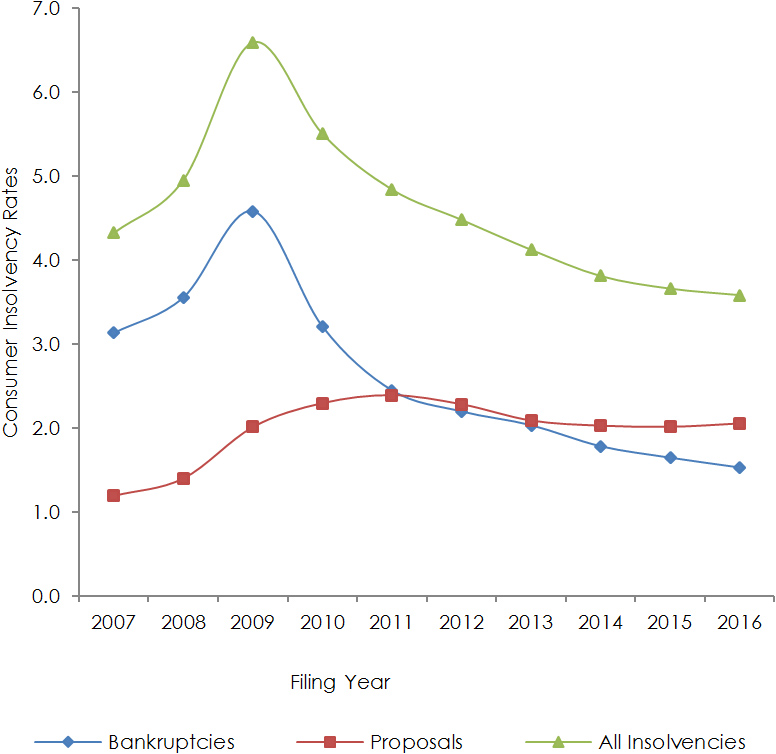
Source: Office of the Superintendent of Bankruptcy
Figure 65: Manitoba

Source: Office of the Superintendent of Bankruptcy
Figure 66: Saskatchewan

Source: Office of the Superintendent of Bankruptcy
Figure 67: Alberta
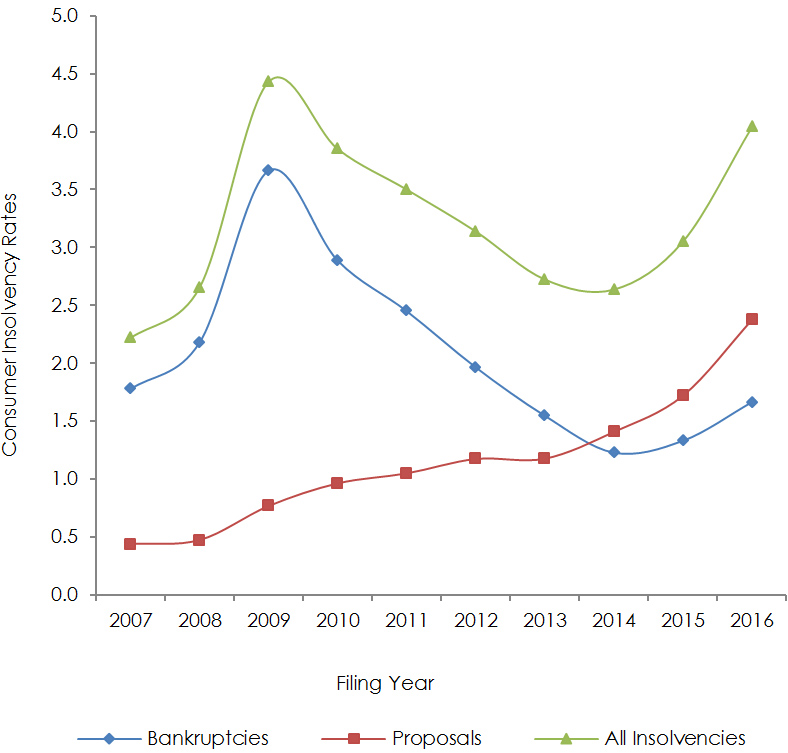
Source: Office of the Superintendent of Bankruptcy
Figure 68: British Columbia
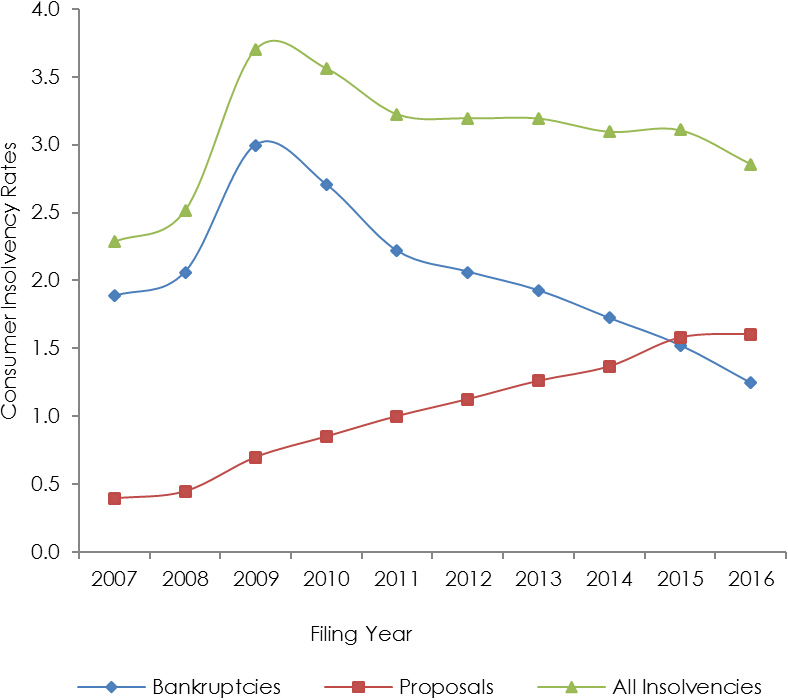
Source: Office of the Superintendent of Bankruptcy
Figure 69: Northwest Territories
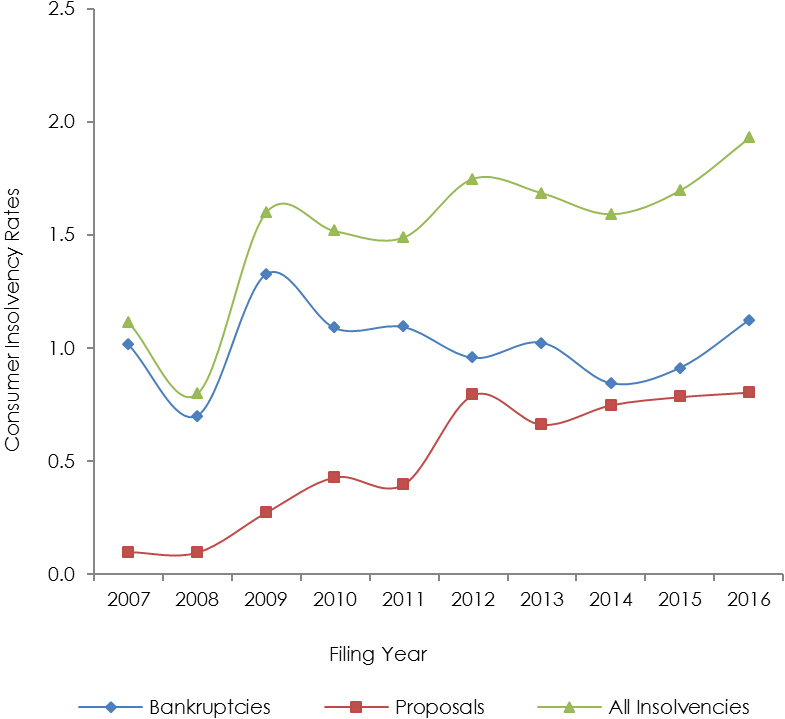
Source: Office of the Superintendent of Bankruptcy
Figure 70: Yukon
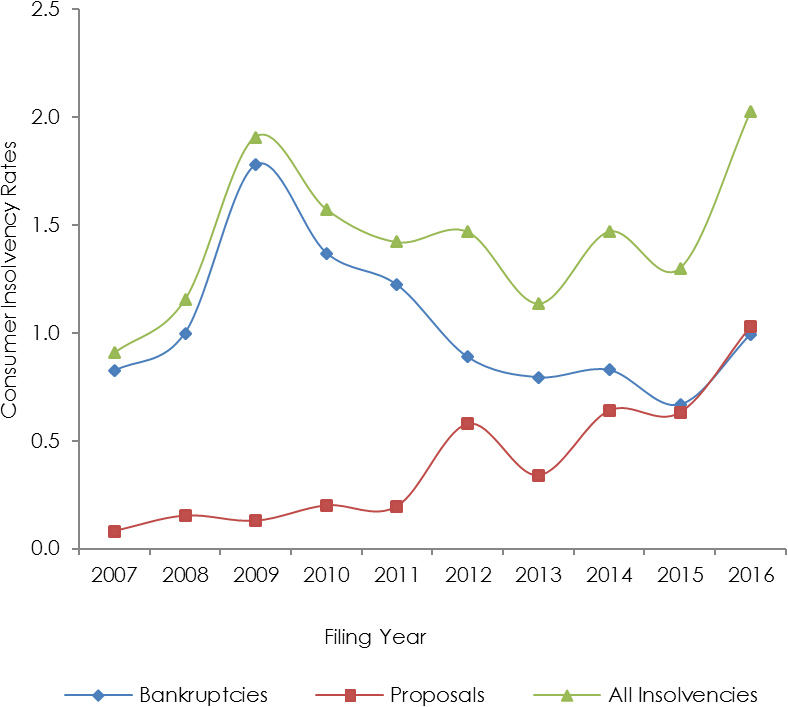
Source: Office of the Superintendent of Bankruptcy
Figure 71: Nunavut
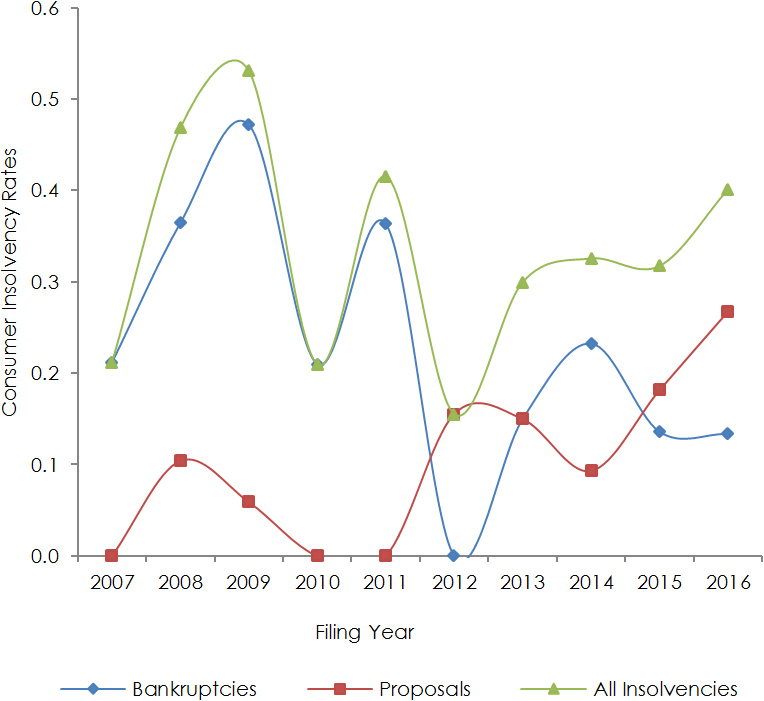
Source: Office of the Superintendent of Bankruptcy
Business Insolvency Rates
Figure 72: Newfoundland and Labrador

Source: Office of the Superintendent of Bankruptcy
Figure 73: Prince Edward Island
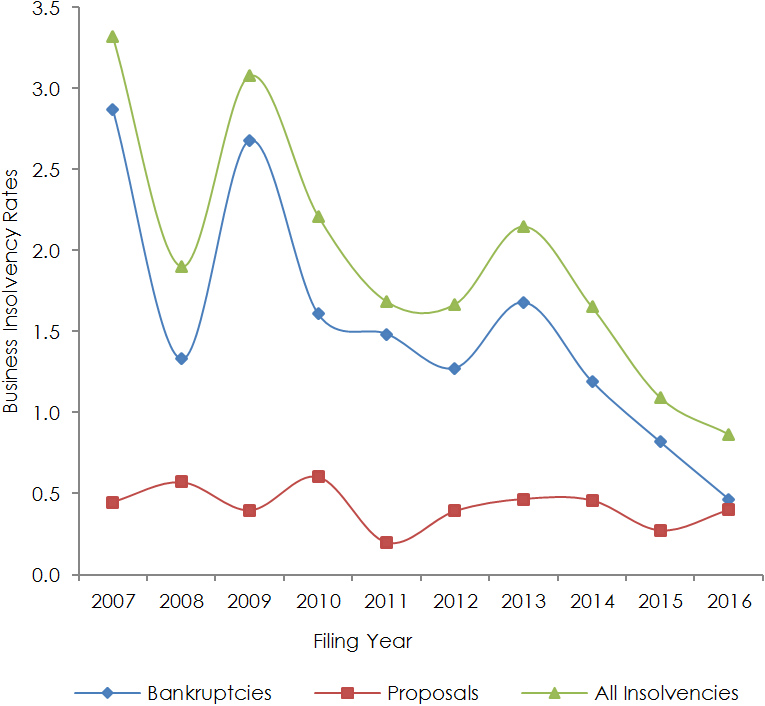
Source: Office of the Superintendent of Bankruptcy
Figure 74: Nova Scotia
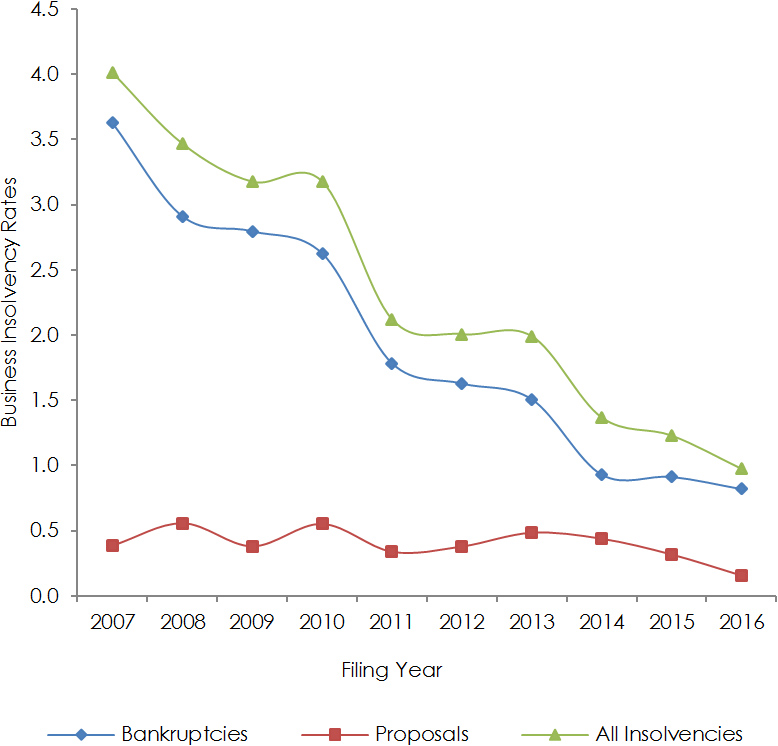
Source: Office of the Superintendent of Bankruptcy
Figure 75: New Brunswick

Source: Office of the Superintendent of Bankruptcy
Figure 76: Quebec
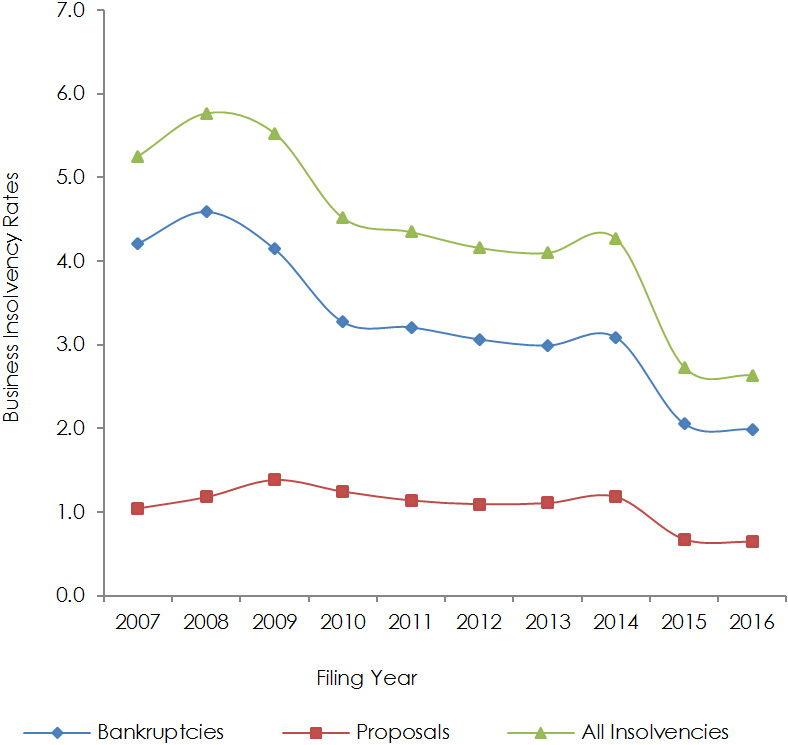
Source: Office of the Superintendent of Bankruptcy
Figure 77: Ontario

Source: Office of the Superintendent of Bankruptcy
Figure 78: Manitoba
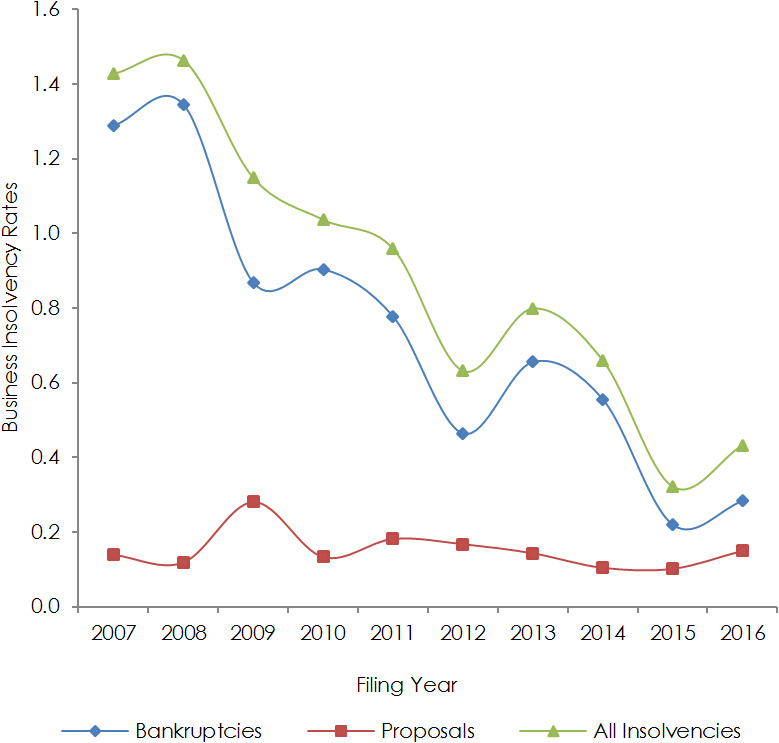
Source: Office of the Superintendent of Bankruptcy
Figure 79: Saskatchewan
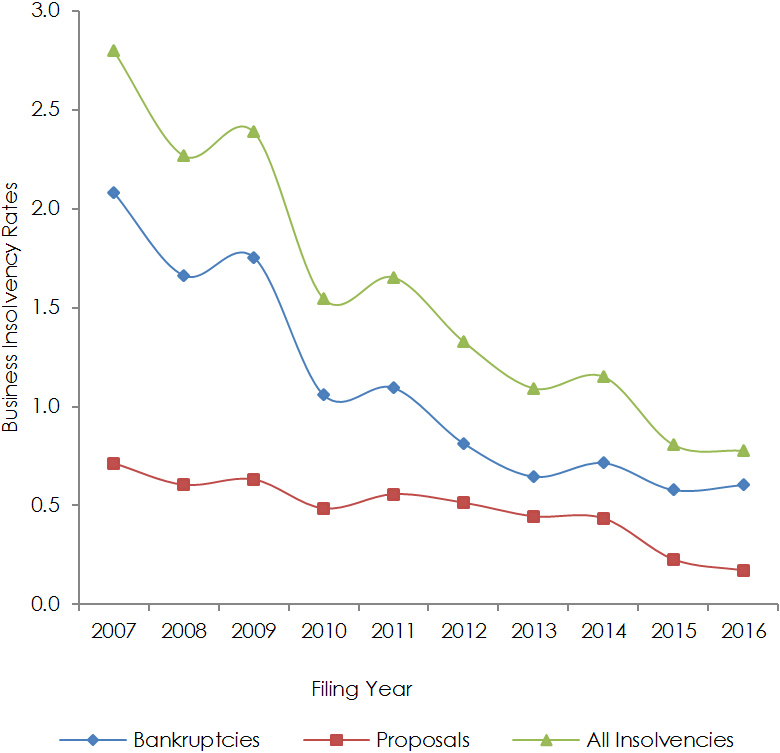
Source: Office of the Superintendent of Bankruptcy
Figure 80: Alberta
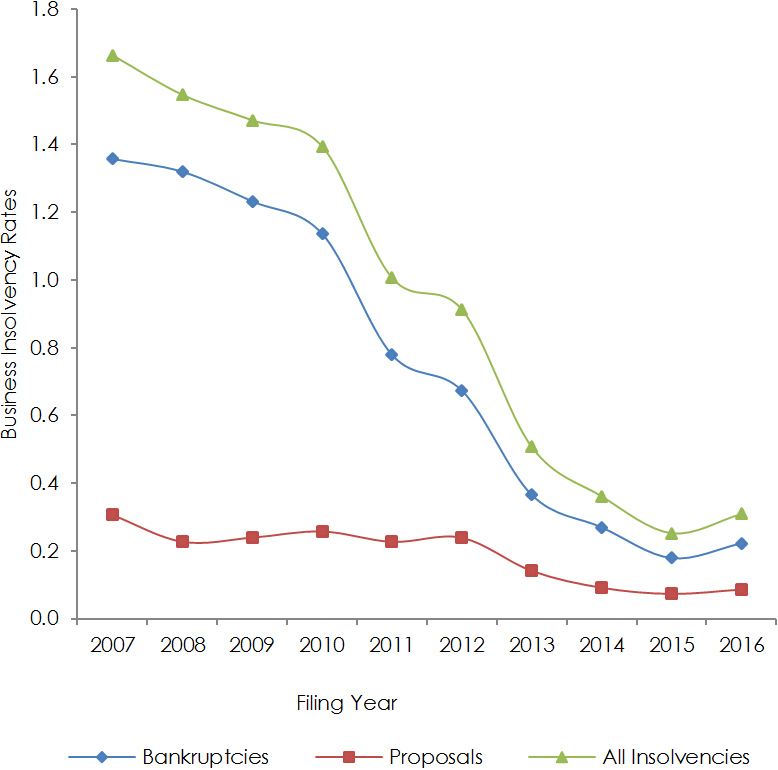
Source: Office of the Superintendent of Bankruptcy
Figure 81: British Columbia

Source: Office of the Superintendent of Bankruptcy
Figure 82: Northwest Territories

Source: Office of the Superintendent of Bankruptcy
Figure 83: Yukon

Source: Office of the Superintendent of Bankruptcy
Figure 84: Nunavut
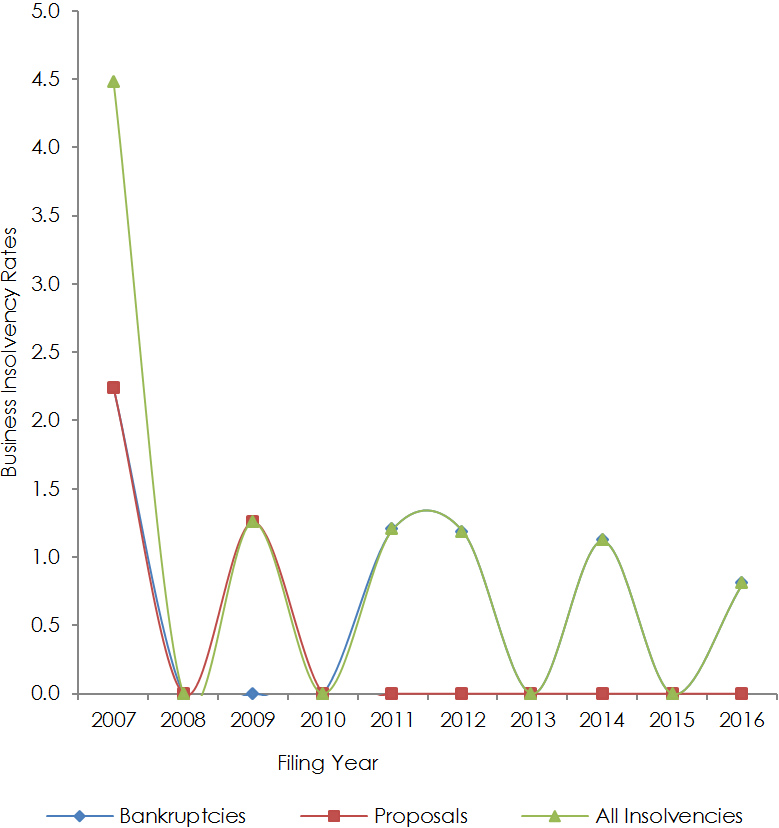
Source: Office of the Superintendent of Bankruptcy
Annex C – Insolvency Volumes and Rates by Province and Territory
| Province | Insolvency Type | 2007 | 2008 | 2009 | 2010 | 2011 | 2012 | 2013 | 2014 | 2015 | 2016 |
|---|---|---|---|---|---|---|---|---|---|---|---|
| Newfoundland | Bankruptcies | 2,173 | 2,172 | 2,575 | 2,399 | 1,981 | 1,626 | 1,545 | 1,375 | 1,519 | 1,574 |
| Proposals | 96 | 48 | 126 | 145 | 126 | 143 | 165 | 200 | 330 | 853 | |
| Insolvencies | 2,269 | 2,220 | 2,701 | 2,544 | 2,107 | 1,769 | 1,710 | 1,575 | 1,849 | 2,427 | |
| Nova Scotia | Bankruptcies | 3,693 | 4,132 | 4,725 | 4,318 | 3,682 | 3,307 | 3,379 | 3,778 | 3,717 | 4,254 |
| Proposals | 555 | 613 | 755 | 979 | 987 | 1,081 | 1,392 | 1,526 | 1,608 | 1,769 | |
| Insolvencies | 4,248 | 4,745 | 5,480 | 5,297 | 4,669 | 4,388 | 4,771 | 5,304 | 5,325 | 6,023 | |
| Prince Edward Island | Bankruptcies | 329 | 458 | 540 | 528 | 535 | 485 | 458 | 515 | 531 | 507 |
| Proposals | 34 | 29 | 37 | 70 | 102 | 150 | 182 | 224 | 291 | 308 | |
| Insolvencies | 363 | 487 | 577 | 598 | 637 | 635 | 640 | 739 | 822 | 815 | |
| New Brunswick | Bankruptcies | 2,605 | 2,851 | 3,388 | 3,179 | 2,891 | 2,959 | 2,910 | 3,089 | 2,873 | 2,949 |
| Proposals | 332 | 461 | 586 | 617 | 669 | 954 | 1,127 | 1,306 | 1,538 | 1,552 | |
| Insolvencies | 2,937 | 3,312 | 3,974 | 3,796 | 3,560 | 3,913 | 4,037 | 4,395 | 4,411 | 4,501 | |
| Quebec | Bankruptcies | 27,107 | 30,474 | 35,883 | 29,620 | 27,196 | 25,887 | 26,812 | 26,137 | 26,223 | 25,901 |
| Proposals | 5,350 | 6,513 | 8,231 | 10,250 | 10,699 | 12,057 | 15,315 | 17,754 | 19,719 | 19,305 | |
| Insolvencies | 32,457 | 36,987 | 44,114 | 39,870 | 37,895 | 37,944 | 42,127 | 43,891 | 45,942 | 45,206 | |
| Ontario | Bankruptcies | 34,024 | 38,637 | 48,729 | 34,533 | 26,805 | 24,278 | 22,731 | 20,069 | 18,842 | 17,595 |
| Proposals | 12,430 | 14,657 | 20,765 | 23,946 | 25,269 | 24,464 | 22,623 | 22,129 | 22,234 | 22,956 | |
| Insolvencies | 46,454 | 53,294 | 69,494 | 58,479 | 52,074 | 48,742 | 45,354 | 42,198 | 41,076 | 40,551 | |
| Manitoba | Bankruptcies | 2,143 | 2,128 | 2,508 | 2,062 | 1,574 | 1,312 | 1,269 | 1,248 | 1,290 | 1,482 |
| Proposals | 554 | 585 | 662 | 689 | 655 | 614 | 650 | 700 | 846 | 1,177 | |
| Insolvencies | 2,697 | 2,713 | 3,170 | 2,751 | 2,229 | 1,926 | 1,919 | 1,948 | 2,136 | 2,659 | |
| Saskatchewan | Bankruptcies | 1,667 | 1,601 | 1,955 | 1,627 | 1,376 | 1,080 | 1,106 | 1,182 | 1,240 | 1,512 |
| Proposals | 610 | 471 | 697 | 843 | 836 | 780 | 699 | 880 | 1,077 | 1,565 | |
| Insolvencies | 2,277 | 2,072 | 2,652 | 2,470 | 2,212 | 1,860 | 1,805 | 2,062 | 2,317 | 3,077 | |
| Alberta | Bankruptcies | 5,217 | 6,513 | 10,391 | 8,528 | 7,293 | 5,989 | 4,826 | 3,964 | 4,375 | 5,548 |
| Proposals | 1,284 | 1,399 | 2,171 | 2,806 | 3,088 | 3,525 | 3,626 | 4,458 | 5,569 | 7,790 | |
| Insolvencies | 6,501 | 7,912 | 12,562 | 11,334 | 10,381 | 9,514 | 8,452 | 8,422 | 9,944 | 13,338 | |
| British Columbia | Bankruptcies | 7,121 | 7,747 | 11,019 | 9,903 | 8,232 | 7,754 | 7,319 | 6,545 | 5,837 | 4,868 |
| Proposals | 1,513 | 1,675 | 2,595 | 3,103 | 3,687 | 4,210 | 4,738 | 5,094 | 5,965 | 6,137 | |
| Insolvencies | 8,634 | 9,422 | 13,614 | 13,006 | 11,919 | 11,964 | 12,057 | 11,639 | 11,802 | 11,005 | |
| Northwest Territories | Bankruptcies | 33 | 23 | 39 | 31 | 33 | 29 | 31 | 26 | 28 | 35 |
| Proposals | 5 | 3 | 8 | 13 | 14 | 25 | 20 | 23 | 24 | 25 | |
| Insolvencies | 38 | 26 | 47 | 44 | 47 | 54 | 51 | 49 | 52 | 60 | |
| Yukon | Bankruptcies | 23 | 31 | 41 | 34 | 32 | 24 | 22 | 22 | 18 | 27 |
| Proposals | 2 | 4 | 5 | 7 | 5 | 14 | 9 | 18 | 17 | 28 | |
| Insolvencies | 25 | 35 | 46 | 41 | 37 | 38 | 31 | 40 | 35 | 55 | |
| Nunavut | Bankruptcies | 5 | 7 | 8 | 4 | 6 | 1 | 3 | 5 | 2 | 4 |
| Proposals | 0 | 2 | 2 | 0 | 1 | 3 | 2 | 2 | 3 | 6 | |
| Insolvencies | 5 | 9 | 10 | 4 | 7 | 4 | 5 | 7 | 5 | 10 | |
| Canada | Bankruptcies | 86,140 | 96,774 | 121,801 | 96,766 | 81,636 | 74,731 | 72,411 | 67,955 | 66,495 | 66,256 |
| Proposals | 22,765 | 26,460 | 36,640 | 43,468 | 46,138 | 48,020 | 50,548 | 54,314 | 59,221 | 63,471 | |
| Insolvencies | 108,905 | 123,234 | 158,441 | 140,234 | 127,774 | 122,751 | 122,959 | 122,269 | 125,716 | 129,727 |
Source: Office of the Superintendent of Bankruptcy
| Province | Insolvency Type | 2007 | 2008 | 2009 | 2010 | 2011 | 2012 | 2013 | 2014 | 2015 | 2016 |
|---|---|---|---|---|---|---|---|---|---|---|---|
| Newfoundland | Bankruptcies | 2,121 | 2,133 | 2,542 | 2,378 | 1,957 | 1,611 | 1,524 | 1,348 | 1,498 | 1,552 |
| Proposals | 94 | 47 | 125 | 143 | 124 | 139 | 154 | 197 | 324 | 847 | |
| Insolvencies | 2,215 | 2,180 | 2,667 | 2,521 | 2,081 | 1,750 | 1,678 | 1,545 | 1,822 | 2,399 | |
| Nova Scotia | Bankruptcies | 3,487 | 3,970 | 4,579 | 4,180 | 3,587 | 3,221 | 3,295 | 3,726 | 3,648 | 4,191 |
| Proposals | 533 | 582 | 735 | 950 | 969 | 1,061 | 1,365 | 1,501 | 1,584 | 1,757 | |
| Insolvencies | 4,020 | 4,552 | 5,314 | 5,130 | 4,556 | 4,282 | 4,660 | 5,227 | 5,232 | 5,948 | |
| Prince Edward Island | Bankruptcies | 297 | 444 | 513 | 512 | 520 | 472 | 440 | 502 | 519 | 500 |
| Proposals | 29 | 23 | 33 | 64 | 100 | 146 | 177 | 219 | 287 | 302 | |
| Insolvencies | 326 | 467 | 546 | 576 | 620 | 618 | 617 | 721 | 806 | 802 | |
| New Brunswick | Bankruptcies | 2,454 | 2,655 | 3,287 | 3,109 | 2,848 | 2,906 | 2,846 | 3,021 | 2,814 | 2,904 |
| Proposals | 300 | 414 | 555 | 604 | 652 | 937 | 1,109 | 1,287 | 1,517 | 1,538 | |
| Insolvencies | 2,754 | 3,069 | 3,842 | 3,713 | 3,500 | 3,843 | 3,955 | 4,308 | 4,331 | 4,442 | |
| Quebec | Bankruptcies | 25,072 | 28,317 | 33,989 | 28,100 | 25,627 | 24,399 | 25,221 | 24,447 | 24,539 | 24,241 |
| Proposals | 4,844 | 5,959 | 7,599 | 9,671 | 10,141 | 11,526 | 14,726 | 17,107 | 19,166 | 18,768 | |
| Insolvencies | 29,916 | 34,276 | 41,588 | 37,771 | 35,768 | 35,925 | 39,947 | 41,554 | 43,705 | 43,009 | |
| Ontario | Bankruptcies | 31,439 | 36,200 | 46,521 | 33,000 | 25,529 | 23,236 | 21,773 | 19,234 | 17,958 | 16,904 |
| Proposals | 11,974 | 14,242 | 20,414 | 23,619 | 24,931 | 24,145 | 22,361 | 21,874 | 21,977 | 22,707 | |
| Insolvencies | 43,413 | 50,442 | 66,935 | 56,619 | 50,460 | 47,381 | 44,134 | 41,108 | 39,935 | 39,611 | |
| Manitoba | Bankruptcies | 2,041 | 2,025 | 2,443 | 1,994 | 1,514 | 1,276 | 1,214 | 1,200 | 1,264 | 1,448 |
| Proposals | 544 | 576 | 639 | 679 | 641 | 601 | 638 | 691 | 834 | 1,159 | |
| Insolvencies | 2,585 | 2,601 | 3,082 | 2,673 | 2,155 | 1,877 | 1,852 | 1,891 | 2,098 | 2,607 | |
| Saskatchewan | Bankruptcies | 1,463 | 1,451 | 1,794 | 1,528 | 1,272 | 1,001 | 1,038 | 1,105 | 1,155 | 1,421 |
| Proposals | 540 | 416 | 639 | 798 | 783 | 730 | 652 | 833 | 1,043 | 1,539 | |
| Insolvencies | 2,003 | 1,867 | 2,433 | 2,326 | 2,055 | 1,731 | 1,690 | 1,938 | 2,198 | 2,960 | |
| Alberta | Bankruptcies | 4,768 | 6,066 | 9,986 | 8,150 | 7,029 | 5,759 | 4,689 | 3,859 | 4,280 | 5,427 |
| Proposals | 1,179 | 1,322 | 2,090 | 2,720 | 3,011 | 3,443 | 3,569 | 4,422 | 5,530 | 7,743 | |
| Insolvencies | 5,947 | 7,388 | 12,076 | 10,870 | 10,040 | 9,202 | 8,258 | 8,281 | 9,810 | 13,170 | |
| British Columbia | Bankruptcies | 6,651 | 7,293 | 10,639 | 9,674 | 8,040 | 7,562 | 7,130 | 6,345 | 5,683 | 4,719 |
| Proposals | 1,404 | 1,589 | 2,490 | 3,049 | 3,636 | 4,134 | 4,672 | 5,038 | 5,897 | 6,087 | |
| Insolvencies | 8,055 | 8,882 | 13,129 | 12,723 | 11,676 | 11,696 | 11,802 | 11,383 | 11,580 | 10,806 | |
| Northwest Territories | Bankruptcies | 31 | 22 | 39 | 31 | 33 | 29 | 31 | 26 | 28 | 35 |
| Proposals | 3 | 3 | 8 | 12 | 12 | 24 | 20 | 23 | 24 | 25 | |
| Insolvencies | 34 | 25 | 47 | 43 | 45 | 53 | 51 | 49 | 52 | 60 | |
| Yukon | Bankruptcies | 20 | 27 | 41 | 34 | 31 | 23 | 20 | 22 | 18 | 27 |
| Proposals | 2 | 4 | 3 | 5 | 5 | 14 | 9 | 17 | 17 | 28 | |
| Insolvencies | 22 | 31 | 44 | 39 | 36 | 37 | 29 | 39 | 35 | 55 | |
| Nunavut | Bankruptcies | 3 | 7 | 8 | 4 | 6 | 0 | 3 | 4 | 2 | 3 |
| Proposals | 0 | 2 | 1 | 0 | 1 | 3 | 2 | 2 | 3 | 6 | |
| Insolvencies | 3 | 9 | 9 | 4 | 7 | 3 | 5 | 6 | 5 | 9 | |
| Canada | Bankruptcies | 79,847 | 90,610 | 116,381 | 92,694 | 77,993 | 71,495 | 69,224 | 64,839 | 63,406 | 63,372 |
| Proposals | 21,446 | 25,179 | 35,331 | 42,314 | 45,006 | 46,903 | 49,454 | 53,211 | 58,203 | 62,506 | |
| Insolvencies | 101,293 | 115,789 | 151,712 | 135,008 | 122,999 | 118,398 | 118,678 | 118,050 | 121,609 | 125,878 |
Source: Office of the Superintendent of Bankruptcy
| Province | Insolvency Type | 2007 | 2008 | 2009 | 2010 | 2011 | 2012 | 2013 | 2014 | 2015 | 2016 |
|---|---|---|---|---|---|---|---|---|---|---|---|
| Newfoundland | Bankruptcies | 52 | 39 | 33 | 21 | 24 | 15 | 21 | 27 | 21 | 22 |
| Proposals | 2 | 1 | 1 | 2 | 2 | 4 | 11 | 3 | 6 | 6 | |
| Insolvencies | 54 | 40 | 34 | 23 | 26 | 19 | 32 | 30 | 27 | 28 | |
| Nova Scotia | Bankruptcies | 206 | 162 | 146 | 138 | 95 | 86 | 84 | 52 | 69 | 63 |
| Proposals | 22 | 31 | 20 | 29 | 18 | 20 | 27 | 25 | 24 | 12 | |
| Insolvencies | 228 | 193 | 166 | 167 | 113 | 106 | 111 | 77 | 93 | 75 | |
| Prince Edward Island | Bankruptcies | 32 | 14 | 27 | 16 | 15 | 13 | 18 | 13 | 12 | 7 |
| Proposals | 5 | 6 | 4 | 6 | 2 | 4 | 5 | 5 | 4 | 6 | |
| Insolvencies | 37 | 20 | 31 | 22 | 17 | 17 | 23 | 18 | 16 | 13 | |
| New Brunswick | Bankruptcies | 151 | 196 | 101 | 70 | 43 | 53 | 64 | 68 | 59 | 45 |
| Proposals | 32 | 47 | 31 | 13 | 17 | 17 | 18 | 19 | 21 | 14 | |
| Insolvencies | 183 | 243 | 132 | 83 | 60 | 70 | 82 | 87 | 80 | 59 | |
| Quebec | Bankruptcies | 2,035 | 2,157 | 1,894 | 1,520 | 1,569 | 1,488 | 1,591 | 1,690 | 1,684 | 1,660 |
| Proposals | 506 | 554 | 632 | 579 | 558 | 531 | 589 | 647 | 553 | 537 | |
| Insolvencies | 2,541 | 2,711 | 2,526 | 2,099 | 2,127 | 2,019 | 2,180 | 2,337 | 2,237 | 2,197 | |
| Ontario | Bankruptcies | 2,585 | 2,437 | 2,208 | 1,533 | 1,276 | 1,042 | 958 | 835 | 884 | 691 |
| Proposals | 456 | 415 | 351 | 327 | 338 | 319 | 262 | 255 | 257 | 249 | |
| Insolvencies | 3,041 | 2,852 | 2,559 | 1,860 | 1,614 | 1,361 | 1,220 | 1,090 | 1,141 | 940 | |
| Manitoba | Bankruptcies | 102 | 103 | 65 | 68 | 60 | 36 | 55 | 48 | 26 | 34 |
| Proposals | 10 | 9 | 23 | 10 | 14 | 13 | 12 | 9 | 12 | 18 | |
| Insolvencies | 112 | 112 | 88 | 78 | 74 | 49 | 67 | 57 | 38 | 52 | |
| Saskatchewan | Bankruptcies | 204 | 150 | 161 | 99 | 104 | 79 | 68 | 77 | 85 | 91 |
| Proposals | 70 | 55 | 58 | 45 | 53 | 50 | 47 | 47 | 34 | 26 | |
| Insolvencies | 274 | 205 | 219 | 144 | 157 | 129 | 115 | 124 | 119 | 117 | |
| Alberta | Bankruptcies | 449 | 447 | 405 | 378 | 264 | 230 | 137 | 105 | 95 | 121 |
| Proposals | 105 | 77 | 81 | 86 | 77 | 82 | 57 | 36 | 39 | 47 | |
| Insolvencies | 554 | 524 | 486 | 464 | 341 | 312 | 194 | 141 | 134 | 168 | |
| British Columbia | Bankruptcies | 470 | 454 | 380 | 229 | 192 | 192 | 189 | 200 | 154 | 149 |
| Proposals | 109 | 86 | 105 | 54 | 51 | 76 | 66 | 56 | 68 | 50 | |
| Insolvencies | 579 | 540 | 485 | 283 | 243 | 268 | 255 | 256 | 222 | 199 | |
| Northwest Territories | Bankruptcies | 2 | 1 | 0 | 0 | 0 | 0 | 0 | 0 | 0 | 0 |
| Proposals | 2 | 0 | 0 | 1 | 2 | 1 | 0 | 0 | 0 | 0 | |
| Insolvencies | 4 | 1 | 0 | 1 | 2 | 1 | 0 | 0 | 0 | 0 | |
| Yukon | Bankruptcies | 3 | 4 | 0 | 0 | 1 | 1 | 2 | 0 | 0 | 0 |
| Proposals | 0 | 0 | 2 | 2 | 0 | 0 | 0 | 1 | 0 | 0 | |
| Insolvencies | 3 | 4 | 2 | 2 | 1 | 1 | 2 | 1 | 0 | 0 | |
| Nunavut | Bankruptcies | 2 | 0 | 0 | 0 | 0 | 1 | 0 | 1 | 0 | 1 |
| Proposals | 0 | 0 | 1 | 0 | 0 | 0 | 0 | 0 | 0 | 0 | |
| Insolvencies | 2 | 0 | 1 | 0 | 0 | 1 | 0 | 1 | 0 | 0 | |
| Canada | Bankruptcies | 6,293 | 6,164 | 5,420 | 4,072 | 3,643 | 3,236 | 3,187 | 3,116 | 3,089 | 2,884 |
| Proposals | 1,319 | 1,281 | 1,309 | 1,154 | 1,132 | 1,117 | 1,094 | 1,103 | 1,018 | 965 | |
| Insolvencies | 7,612 | 7,445 | 6,729 | 5,226 | 4,775 | 4,353 | 4,281 | 4,219 | 4,107 | 3,849 |
Source: Office of the Superintendent of Bankruptcy
| Province | Insolvency Type | 2007 | 2008 | 2009 | 2010 | 2011 | 2012 | 2013 | 2014 | 2015 | 2016 |
|---|---|---|---|---|---|---|---|---|---|---|---|
| Newfoundland | Bankruptcies | 5.2 | 5.2 | 6.2 | 5.8 | 4.7 | 3.9 | 3.7 | 3.1 | 3.5 | 3.6 |
| Proposals | 0.2 | 0.1 | 0.3 | 0.3 | 0.3 | 0.3 | 0.4 | 0.5 | 0.8 | 2.0 | |
| Insolvencies | 5.4 | 5.3 | 6.5 | 6.1 | 5.0 | 4.3 | 4.1 | 3.6 | 4.3 | 5.6 | |
| Nova Scotia | Bankruptcies | 2.7 | 4.0 | 4.7 | 4.6 | 4.6 | 4.1 | 3.8 | 4.3 | 4.5 | 4.3 |
| Proposals | 0.3 | 0.2 | 0.3 | 0.6 | 0.9 | 1.3 | 1.5 | 1.9 | 2.5 | 2.6 | |
| Insolvencies | 3.0 | 4.2 | 5.0 | 5.2 | 5.5 | 5.3 | 5.3 | 6.2 | 7.0 | 6.9 | |
| Prince Edward Island | Bankruptcies | 4.6 | 5.2 | 6.2 | 5.6 | 4.8 | 4.3 | 4.4 | 5.0 | 4.8 | 5.5 |
| Proposals | 0.7 | 0.8 | 1.0 | 1.3 | 1.3 | 1.4 | 1.8 | 2.0 | 2.1 | 2.3 | |
| Insolvencies | 5.3 | 6.0 | 7.2 | 6.9 | 6.1 | 5.7 | 6.2 | 7.0 | 6.9 | 7.8 | |
| New Brunswick | Bankruptcies | 4.1 | 4.4 | 5.5 | 5.3 | 4.8 | 4.9 | 4.8 | 5.0 | 4.7 | 4.8 |
| Proposals | 0.5 | 0.7 | 0.9 | 1.0 | 1.1 | 1.6 | 1.9 | 2.1 | 2.5 | 2.6 | |
| Insolvencies | 4.5 | 5.1 | 6.5 | 6.3 | 5.9 | 6.5 | 6.6 | 7.2 | 7.2 | 7.4 | |
| Quebec | Bankruptcies | 4.1 | 4.6 | 5.5 | 4.5 | 4.1 | 3.8 | 3.9 | 3.7 | 3.7 | 3.6 |
| Proposals | 0.8 | 1.0 | 1.2 | 1.6 | 1.6 | 1.8 | 2.3 | 2.6 | 2.9 | 2.8 | |
| Insolvencies | 4.8 | 5.5 | 6.8 | 6.1 | 5.7 | 5.6 | 6.2 | 6.3 | 6.6 | 6.5 | |
| Ontario | Bankruptcies | 3.1 | 3.6 | 4.6 | 3.2 | 2.4 | 2.2 | 2.0 | 1.8 | 1.6 | 1.5 |
| Proposals | 1.2 | 1.4 | 2.0 | 2.3 | 2.4 | 2.3 | 2.1 | 2.0 | 2.0 | 2.1 | |
| Insolvencies | 4.3 | 5.0 | 6.6 | 5.5 | 4.8 | 4.5 | 4.1 | 3.8 | 3.7 | 3.6 | |
| Manitoba | Bankruptcies | 2.2 | 2.2 | 2.8 | 2.2 | 1.7 | 1.4 | 1.3 | 1.3 | 1.3 | 1.5 |
| Proposals | 0.6 | 0.6 | 0.7 | 0.8 | 0.7 | 0.7 | 0.7 | 0.7 | 0.9 | 1.2 | |
| Insolvencies | 2.8 | 2.8 | 3.5 | 3.0 | 2.4 | 2.0 | 2.0 | 2.0 | 2.2 | 2.7 | |
| Saskatchewan | Bankruptcies | 1.9 | 1.9 | 2.4 | 2.0 | 1.7 | 1.3 | 1.3 | 1.4 | 1.4 | 1.7 |
| Proposals | 0.7 | 0.5 | 0.9 | 1.1 | 1.0 | 0.9 | 0.8 | 1.0 | 1.3 | 1.9 | |
| Insolvencies | 2.6 | 2.4 | 3.3 | 3.1 | 2.7 | 2.2 | 2.2 | 2.4 | 2.7 | 3.6 | |
| Alberta | Bankruptcies | 1.8 | 2.2 | 3.7 | 2.9 | 2.5 | 2.0 | 1.5 | 1.2 | 1.3 | 1.7 |
| Proposals | 0.4 | 0.5 | 0.8 | 1.0 | 1.0 | 1.2 | 1.2 | 1.4 | 1.7 | 2.4 | |
| Insolvencies | 2.2 | 2.7 | 4.4 | 3.8 | 3.5 | 3.1 | 2.7 | 2.6 | 3.1 | 4.0 | |
| British Columbia | Bankruptcies | 1.9 | 2.1 | 3.0 | 2.7 | 2.2 | 2.1 | 1.9 | 1.7 | 1.5 | 1.2 |
| Proposals | 0.4 | 0.5 | 0.7 | 0.9 | 1.0 | 1.1 | 1.3 | 1.4 | 1.6 | 1.6 | |
| Insolvencies | 2.3 | 2.5 | 3.7 | 3.6 | 3.2 | 3.2 | 3.2 | 3.1 | 3.1 | 2.9 | |
| Northwest Territories | Bankruptcies | 0.8 | 1.0 | 1.8 | 1.4 | 1.2 | 0.9 | 0.8 | 0.8 | 0.7 | 1.0 |
| Proposals | 0.1 | 0.2 | 0.1 | 0.2 | 0.2 | 0.6 | 0.3 | 0.6 | 0.6 | 1.0 | |
| Insolvencies | 0.9 | 1.2 | 1.9 | 1.6 | 1.4 | 1.5 | 1.1 | 1.5 | 1.3 | 2.0 | |
| Yukon | Bankruptcies | 1.0 | 0.7 | 1.3 | 1.1 | 1.1 | 1.0 | 1.0 | 0.8 | 0.9 | 1.1 |
| Proposals | 0.1 | 0.1 | 0.3 | 0.4 | 0.4 | 0.8 | 0.7 | 0.7 | 0.8 | 0.8 | |
| Insolvencies | 1.1 | 0.8 | 1.6 | 1.5 | 1.5 | 1.7 | 1.7 | 1.6 | 1.7 | 1.9 | |
| Nunavut | Bankruptcies | 0.2 | 0.4 | 0.5 | 0.2 | 0.4 | 0.0 | 0.1 | 0.2 | 0.1 | 0.1 |
| Proposals | 0.0 | 0.1 | 0.1 | 0.0 | 0.0 | 0.2 | 0.1 | 0.1 | 0.2 | 0.3 | |
| Insolvencies | 0.2 | 0.5 | 0.5 | 0.2 | 0.4 | 0.2 | 0.3 | 0.3 | 0.3 | 0.4 | |
| Canada | Bankruptcies | 3.1 | 3.4 | 4.5 | 3.5 | 2.9 | 2.6 | 2.5 | 2.3 | 2.3 | 2.2 |
| Proposals | 0.8 | 1.0 | 1.4 | 1.6 | 1.7 | 1.7 | 1.8 | 1.9 | 2.1 | 2.2 | |
| Insolvencies | 3.9 | 4.4 | 5.8 | 5.1 | 4.6 | 4.4 | 4.3 | 4.2 | 4.3 | 4.4 |
Source: Office of the Superintendent of Bankruptcy
Consumer insolvency rates are defined as the number of insolvent consumers per 1,000 Canadian residents.
| Province | Insolvency Type | 2007 | 2008 | 2009 | 2010 | 2011 | 2012 | 2013 | 2014 | 2015 | 2016 |
|---|---|---|---|---|---|---|---|---|---|---|---|
| Newfoundland | Bankruptcies | 2.0 | 1.5 | 1.3 | 0.8 | 0.9 | 0.6 | 0.8 | 1.0 | 0.5 | 0.5 |
| Proposals | 0.0 | 0.0 | 0.0 | 0.1 | 0.1 | 0.1 | 0.4 | 0.1 | 0.1 | 0.1 | |
| Insolvencies | 2.0 | 1.5 | 1.3 | 0.9 | 1.0 | 0.7 | 1.1 | 1.1 | 0.6 | 0.7 | |
| Nova Scotia | Bankruptcies | 2.9 | 1.3 | 2.7 | 1.6 | 1.5 | 1.3 | 1.7 | 1.2 | 0.8 | 0.5 |
| Proposals | 0.4 | 0.6 | 0.4 | 0.6 | 0.2 | 0.4 | 0.5 | 0.5 | 0.3 | 0.4 | |
| Insolvencies | 3.3 | 1.9 | 3.1 | 2.2 | 1.7 | 1.7 | 2.1 | 1.7 | 1.1 | 0.9 | |
| Prince Edward Island | Bankruptcies | 3.6 | 2.9 | 2.8 | 2.6 | 1.8 | 1.6 | 1.5 | 0.9 | 0.9 | 0.8 |
| Proposals | 0.4 | 0.6 | 0.4 | 0.6 | 0.3 | 0.4 | 0.5 | 0.4 | 0.3 | 0.2 | |
| Insolvencies | 4.0 | 3.5 | 3.2 | 3.2 | 2.1 | 2.0 | 2.0 | 1.4 | 1.2 | 1.0 | |
| New Brunswick | Bankruptcies | 3.4 | 4.6 | 2.4 | 1.7 | 1.0 | 1.3 | 1.5 | 1.5 | 1.0 | 0.8 |
| Proposals | 0.7 | 1.1 | 0.7 | 0.3 | 0.4 | 0.4 | 0.4 | 0.4 | 0.4 | 0.2 | |
| Insolvencies | 4.1 | 5.7 | 3.2 | 2.0 | 1.4 | 1.7 | 1.9 | 1.9 | 1.4 | 1.0 | |
| Quebec | Bankruptcies | 4.2 | 4.6 | 4.1 | 3.3 | 3.2 | 3.1 | 3.0 | 3.1 | 2.1 | 2.0 |
| Proposals | 1.0 | 1.2 | 1.4 | 1.2 | 1.1 | 1.1 | 1.1 | 1.2 | 0.7 | 0.6 | |
| Insolvencies | 5.3 | 5.8 | 5.5 | 4.5 | 4.3 | 4.2 | 4.1 | 4.3 | 2.7 | 2.6 | |
| Ontario | Bankruptcies | 2.9 | 2.7 | 2.6 | 1.8 | 1.4 | 1.2 | 1.0 | 0.8 | 0.6 | 0.5 |
| Proposals | 0.5 | 0.5 | 0.4 | 0.4 | 0.4 | 0.4 | 0.3 | 0.3 | 0.2 | 0.2 | |
| Insolvencies | 3.3 | 3.2 | 3.0 | 2.2 | 1.8 | 1.6 | 1.3 | 1.1 | 0.8 | 0.6 | |
| Manitoba | Bankruptcies | 1.3 | 1.3 | 0.9 | 0.9 | 0.8 | 0.5 | 0.7 | 0.6 | 0.2 | 0.3 |
| Proposals | 0.1 | 0.1 | 0.3 | 0.1 | 0.2 | 0.2 | 0.1 | 0.1 | 0.1 | 0.1 | |
| Insolvencies | 1.4 | 1.5 | 1.1 | 1.0 | 1.0 | 0.6 | 0.8 | 0.7 | 0.3 | 0.4 | |
| Saskatchewan | Bankruptcies | 2.1 | 1.7 | 1.8 | 1.1 | 1.1 | 0.8 | 0.6 | 0.7 | 0.6 | 0.6 |
| Proposals | 0.7 | 0.6 | 0.6 | 0.5 | 0.6 | 0.5 | 0.4 | 0.4 | 0.2 | 0.2 | |
| Insolvencies | 2.8 | 2.3 | 2.4 | 1.5 | 1.7 | 1.3 | 1.1 | 1.2 | 0.8 | 0.8 | |
| Alberta | Bankruptcies | 1.4 | 1.3 | 1.2 | 1.1 | 0.8 | 0.7 | 0.4 | 0.3 | 0.2 | 0.2 |
| Proposals | 0.3 | 0.2 | 0.2 | 0.3 | 0.2 | 0.2 | 0.1 | 0.1 | 0.1 | 0.1 | |
| Insolvencies | 1.7 | 1.5 | 1.5 | 1.4 | 1.0 | 0.9 | 0.5 | 0.4 | 0.3 | 0.3 | |
| British Columbia | Bankruptcies | 1.3 | 1.2 | 1.1 | 0.6 | 0.5 | 0.5 | 0.5 | 0.5 | 0.3 | 0.3 |
| Proposals | 0.3 | 0.2 | 0.3 | 0.2 | 0.1 | 0.2 | 0.2 | 0.1 | 0.1 | 0.1 | |
| Insolvencies | 1.6 | 1.5 | 1.4 | 0.8 | 0.7 | 0.7 | 0.7 | 0.6 | 0.4 | 0.3 | |
| Northwest Territories | Bankruptcies | 0.7 | 1.4 | 0.0 | 0.0 | 0.3 | 0.3 | 0.6 | 0.0 | 0.0 | 0.0 |
| Proposals | 0.0 | 0.0 | 0.7 | 0.4 | 0.0 | 0.0 | 0.0 | 0.3 | 0.0 | 0.0 | |
| Insolvencies | 0.7 | 1.4 | 0.7 | 0.4 | 0.3 | 0.3 | 0.6 | 0.3 | 0.0 | 0.0 | |
| Yukon | Bankruptcies | 0.7 | 0.4 | 0.0 | 0.0 | 0.0 | 0.0 | 0.0 | 0.0 | 0.0 | 0.0 |
| Proposals | 0.0 | 0.0 | 0.8 | 0.4 | 1.2 | 0.4 | 0.0 | 0.0 | 0.0 | 0.0 | |
| Insolvencies | 0.7 | 0.4 | 0.8 | 0.4 | 1.2 | 0.4 | 0.0 | 0.0 | 0.0 | 0.0 | |
| Nunavut | Bankruptcies | 2.2 | 0.0 | 0.0 | 0.0 | 1.2 | 1.2 | 0.0 | 1.1 | 0.0 | 0.8 |
| Proposals | 2.2 | 0.0 | 1.3 | 0.0 | 0.0 | 0.0 | 0.0 | 0.0 | 0.0 | 0.0 | |
| Insolvencies | 4.5 | 0.0 | 1.3 | 0.0 | 1.2 | 1.2 | 0.0 | 1.1 | 0.0 | 0.8 | |
| Canada | Bankruptcies | 2.6 | 2.6 | 2.4 | 1.8 | 1.5 | 1.4 | 1.2 | 1.2 | 0.8 | 0.7 |
| Proposals | 0.5 | 0.5 | 0.6 | 0.5 | 0.5 | 0.5 | 0.4 | 0.4 | 0.3 | 0.2 | |
| Insolvencies | 3.2 | 3.1 | 2.9 | 2.3 | 2.0 | 1.8 | 1.7 | 1.6 | 1.1 | 1.0 |
Source: Office of the Superintendent of Bankruptcy
Business insolvency rates are defined as the number of insolvent businesses per 1,000 Canadian businesses.
Annex D – Insolvency Volumes by Age, Gender and Industry Sector
| Age Groups | Insolvency Type | 2007 | 2008 | 2009 | 2010 | 2011 | 2012 | 2013 | 2014 | 2015 | 2016 |
|---|---|---|---|---|---|---|---|---|---|---|---|
| 18 to 24 years | Bankruptcies | 4,873 | 5,183 | 5,485 | 3,417 | 2,367 | 2,122 | 2,199 | 2,103 | 2,306 | 2,451 |
| Proposals | 1,017 | 1,088 | 1,132 | 1,128 | 918 | 907 | 1,236 | 1,279 | 1,519 | 1,736 | |
| Insolvencies | 5,890 | 6,271 | 6,617 | 4,545 | 3,285 | 3,029 | 3,435 | 3,382 | 3,825 | 4,187 | |
| 25 to 44 years | Bankruptcies | 41,248 | 46,265 | 58,038 | 43,884 | 35,556 | 32,186 | 30,599 | 27,959 | 27,044 | 26,687 |
| Proposals | 11,598 | 13,456 | 18,290 | 20,813 | 21,646 | 22,358 | 23,435 | 25,453 | 27,702 | 30,148 | |
| Insolvencies | 52,846 | 59,721 | 76,328 | 64,697 | 57,202 | 54,544 | 54,034 | 53,412 | 54,746 | 56,835 | |
| 45 to 64 years | Bankruptcies | 27,976 | 32,298 | 43,882 | 36,429 | 31,562 | 29,369 | 28,389 | 26,668 | 25,710 | 25,291 |
| Proposals | 7,971 | 9,662 | 14,326 | 18,134 | 19,693 | 20,600 | 21,546 | 22,763 | 24,696 | 25,793 | |
| Insolvencies | 35,947 | 41,960 | 58,208 | 54,563 | 51,255 | 49,969 | 49,935 | 49,431 | 50,406 | 51,084 | |
| 65 years and older | Bankruptcies | 5,722 | 6,835 | 8,933 | 8,936 | 8,501 | 7,806 | 8,031 | 8,100 | 8,341 | 8,940 |
| Proposals | 852 | 969 | 1,572 | 2,232 | 2,746 | 3,036 | 3,236 | 3,716 | 4,285 | 4,829 | |
| Insolvencies | 6,574 | 7,804 | 10,505 | 11,168 | 11,247 | 10,842 | 11,267 | 11,816 | 12,626 | 13,769 | |
| All* | Bankruptcies | 79,819 | 90,581 | 116,338 | 92,666 | 77,986 | 71,483 | 69,218 | 64,830 | 63,401 | 63,369 |
| Proposals | 21,438 | 25,175 | 35,320 | 42,307 | 45,003 | 46,901 | 49,453 | 53,211 | 58,202 | 62,506 | |
| Insolvencies | 101,257 | 115,756 | 151,658 | 134,973 | 122,989 | 118,384 | 118,671 | 118,041 | 121,603 | 125,875 |
Source: Office of the Superintendent of Bankruptcy
*A few files have missing date of birth which results in files with missing age.
| Age Groups | Insolvency Type | 2007 | 2008 | 2009 | 2010 | 2011 | 2012 | 2013 | 2014 | 2015 | 2016 |
|---|---|---|---|---|---|---|---|---|---|---|---|
| 18 to 24 years | Bankruptcies | 6.1% | 5.7% | 4.7% | 3.7% | 3.0% | 3.0% | 3.2% | 3.2% | 3.6% | 3.9% |
| Proposals | 4.7% | 4.3% | 3.2% | 2.7% | 2.0% | 1.9% | 2.5% | 2.4% | 2.6% | 2.8% | |
| Insolvencies | 5.8% | 5.4% | 4.4% | 3.4% | 2.7% | 2.6% | 2.9% | 2.9% | 3.1% | 3.3% | |
| 25 to 44 years | Bankruptcies | 51.7% | 51.1% | 49.9% | 47.4% | 45.6% | 45.0% | 44.2% | 43.1% | 42.7% | 42.1% |
| Proposals | 54.1% | 53.4% | 51.8% | 49.2% | 48.1% | 47.7% | 47.4% | 47.8% | 47.6% | 48.2% | |
| Insolvencies | 52.2% | 51.6% | 50.3% | 47.9% | 46.5% | 46.1% | 45.5% | 45.2% | 45.0% | 45.2% | |
| 45 to 64 years | Bankruptcies | 35.0% | 35.7% | 37.7% | 39.3% | 40.5% | 41.1% | 41.0% | 41.1% | 40.6% | 39.9% |
| Proposals | 37.2% | 38.4% | 40.6% | 42.9% | 43.8% | 43.9% | 43.6% | 42.8% | 42.4% | 41.3% | |
| Insolvencies | 35.5% | 36.2% | 38.4% | 40.4% | 41.7% | 42.2% | 42.1% | 41.9% | 41.5% | 40.6% | |
| 65 years and older | Bankruptcies | 7.2% | 7.5% | 7.7% | 9.6% | 10.9% | 10.9% | 11.6% | 12.6% | 13.1% | 14.1% |
| Proposals | 4.0% | 3.9% | 4.4% | 5.2% | 6.1% | 6.5% | 6.5% | 7.0% | 7.4% | 7.7% | |
| Insolvencies | 6.5% | 6.8% | 6.9% | 8.3% | 9.1% | 9.1% | 9.5% | 10.0% | 10.4% | 10.9% | |
| All | Bankruptcies | 100.0% | 100.0% | 100.0% | 100.0% | 100.0% | 100.0% | 100.0% | 100.0% | 100.0% | 100.0% |
| Proposals | 100.0% | 100.0% | 100.0% | 100.0% | 100.0% | 100.0% | 100.0% | 100.0% | 100.0% | 100.0% | |
| Insolvencies | 100.0% | 100.0% | 100.0% | 100.0% | 100.0% | 100.0% | 100.0% | 100.0% | 100.0% | 100.0% |
Source: Office of the Superintendent of Bankruptcy
| Age Groups | 2007 | 2008 | 2009 | 2010 | 2011 | 2012 | 2013 | 2014 | 2015 | 2016 |
|---|---|---|---|---|---|---|---|---|---|---|
| 18 to 24 years | 3,144,484 | 3,180,582 | 3,219,355 | 3,252,235 | 3,279,835 | 3,328,901 | 3,370,796 | 3,390,654 | 3,358,826 | 3,348,529 |
| 25 to 44 years | 9,356,071 | 9,329,995 | 9,322,710 | 9,328,475 | 9,356,801 | 9,448,533 | 9,541,879 | 9,644,237 | 9,717,037 | 9,848,813 |
| 45 to 64 years | 8,998,851 | 9,246,569 | 9,478,664 | 9,684,189 | 9,814,702 | 9,876,737 | 9,935,024 | 9,991,198 | 10,032,439 | 10,079,893 |
| 65 years and over | 4,412,638 | 4,532,605 | 4,661,110 | 4,796,143 | 4,950,310 | 5,167,113 | 5,383,902 | 5,589,292 | 5,786,907 | 5,990,511 |
| All | 25,912,044 | 26,289,751 | 26,681,839 | 27,061,042 | 27,401,648 | 27,821,284 | 28,231,601 | 28,615,381 | 28,895,209 | 29,267,746 |
Source: CANSIM Table 051-0001
| Age Groups | 2007 | 2008 | 2009 | 2010 | 2011 | 2012 | 2013 | 2014 | 2015 | 2016 |
|---|---|---|---|---|---|---|---|---|---|---|
| 18 to 24 years | 12.2% | 12.1% | 12.1% | 12.0% | 12.0% | 12.0% | 11.9% | 11.8% | 11.7% | 11.4% |
| 25 to 44 years | 36.1% | 35.5% | 34.9% | 34.5% | 34.1% | 34.0% | 33.8% | 33.8% | 33.6% | 33.7% |
| 45 to 64 years | 34.7% | 35.2% | 35.5% | 35.8% | 35.8% | 35.4% | 35.2% | 34.9% | 34.7% | 34.4% |
| 65 years and over | 17.0% | 17.2% | 17.5% | 17.7% | 18.1% | 18.6% | 19.1% | 20.5% | 20.0% | 20.5% |
| All | 100.0% | 100.0% | 100.0% | 100.0% | 100.0% | 100.0% | 100.0% | 100.0% | 100.0% | 100.0% |
Source: CANSIM Table 051-0001
| Top Five Sectors | Insolvency Type | 2007 | 2008 | 2009 | 2010 | 2011 | 2012 | 2013 | 2014 | 2015 | 2016 |
|---|---|---|---|---|---|---|---|---|---|---|---|
| Construction | Bankruptcies | 1,087 | 1,073 | 833 | 696 | 620 | 607 | 564 | 530 | 572 | 520 |
| Proposals | 200 | 166 | 166 | 167 | 162 | 226 | 184 | 189 | 203 | 191 | |
| Insolvencies | 1,287 | 1,239 | 999 | 863 | 782 | 833 | 748 | 719 | 775 | 711 | |
| Manufacturing | Bankruptcies | 585 | 626 | 586 | 426 | 393 | 308 | 295 | 276 | 267 | 216 |
| Proposals | 173 | 167 | 173 | 138 | 161 | 127 | 128 | 110 | 113 | 83 | |
| Insolvencies | 758 | 793 | 759 | 564 | 554 | 435 | 423 | 386 | 380 | 299 | |
| Retail Trade | Bankruptcies | 900 | 837 | 783 | 604 | 505 | 435 | 421 | 376 | 385 | 331 |
| Proposals | 183 | 152 | 163 | 148 | 143 | 136 | 107 | 122 | 117 | 123 | |
| Insolvencies | 1,083 | 989 | 946 | 752 | 648 | 571 | 528 | 498 | 502 | 454 | |
| Transportation and Warehousing | Bankruptcies | 601 | 652 | 479 | 334 | 252 | 213 | 187 | 185 | 159 | 177 |
| Proposals | 107 | 131 | 118 | 69 | 58 | 46 | 50 | 88 | 60 | 48 | |
| Insolvencies | 708 | 783 | 597 | 403 | 310 | 259 | 237 | 273 | 219 | 225 | |
| Accommodation and Food Services | Bankruptcies | 728 | 739 | 635 | 473 | 510 | 440 | 480 | 493 | 526 | 473 |
| Proposals | 139 | 126 | 180 | 166 | 148 | 184 | 180 | 167 | 132 | 137 | |
| Insolvencies | 867 | 865 | 815 | 639 | 658 | 624 | 660 | 660 | 658 | 610 |
Source: Office of the Superintendent of Bankruptcy
| Top Five Sectors | Insolvency Type | 2007 | 2008 | 2009 | 2010 | 2011 | 2012 | 2013 | 2014 | 2015 | 2016 |
|---|---|---|---|---|---|---|---|---|---|---|---|
| Construction | Bankruptcies | 17% | 17% | 15% | 17% | 17% | 19% | 18% | 17% | 19% | 18% |
| Proposals | 15% | 13% | 13% | 14% | 14% | 20% | 17% | 17% | 20% | 20% | |
| Insolvencies | 17% | 17% | 15% | 17% | 16% | 19% | 17% | 17% | 19% | 18% | |
| Manufacturing | Bankruptcies | 9% | 10% | 11% | 10% | 11% | 10% | 9% | 9% | 9% | 7% |
| Proposals | 13% | 13% | 13% | 12% | 14% | 11% | 12% | 10% | 11% | 9% | |
| Insolvencies | 10% | 11% | 11% | 11% | 12% | 10% | 10% | 9% | 9% | 8% | |
| Retail Trade | Bankruptcies | 14% | 14% | 14% | 15% | 14% | 13% | 13% | 12% | 12% | 11% |
| Proposals | 14% | 12% | 12% | 13% | 13% | 12% | 10% | 11% | 11% | 13% | |
| Insolvencies | 14% | 13% | 14% | 14% | 14% | 13% | 12% | 12% | 12% | 12% | |
| Transportation and Warehousing | Bankruptcies | 10% | 11% | 9% | 8% | 7% | 7% | 6% | 6% | 5% | 6% |
| Proposals | 8% | 10% | 9% | 6% | 5% | 4% | 5% | 8% | 6% | 5% | |
| Insolvencies | 9% | 11% | 9% | 8% | 6% | 6% | 6% | 6% | 5% | 6% | |
| Accommodation and Food Services | Bankruptcies | 12% | 12% | 12% | 12% | 14% | 14% | 15% | 16% | 17% | 16% |
| Proposals | 11% | 10% | 14% | 14% | 13% | 16% | 16% | 15% | 13% | 14% | |
| Insolvencies | 11% | 12% | 12% | 12% | 14% | 14% | 15% | 16% | 16% | 16% |
Source: Office of the Superintendent of Bankruptcy
| Top Five Sectors | 2007 | 2008 | 2009 | 2010 | 2011 | 2012 | 2013 | 2014 | 2015 | 2016 |
|---|---|---|---|---|---|---|---|---|---|---|
| Construction | 278,259 | 270,933 | 263,628 | 270,080 | 278,470 | 278,202 | 304,429 | 316,451 | 356,306 | 364,091 |
| Manufacturing | 97,994 | 92,521 | 85,791 | 84,056 | 81,555 | 78,816 | 83,890 | 84,821 | 89,506 | 89,655 |
| Retail Trade | 219,651 | 212,244 | 199,870 | 194,947 | 197,923 | 196,547 | 211,108 | 213,193 | 229,971 | 230,403 |
| Transportation and Warehousing | 131,612 | 130,005 | 125,278 | 125,348 | 125,207 | 124,314 | 144,616 | 152,764 | 180,010 | 185,952 |
| Accommodation and Food Services | 106,096 | 104,823 | 98,232 | 98,682 | 99,176 | 98,604 | 105,674 | 108,281 | 113,340 | 114,993 |
Source: Statistics Canada (Custom request)
| Top Five Sectors | 2007 | 2008 | 2009 | 2010 | 2011 | 2012 | 2013 | 2014 | 2015 | 2016 |
|---|---|---|---|---|---|---|---|---|---|---|
| Construction | 12% | 11% | 12% | 12% | 12% | 12% | 12% | 12% | 9% | 9% |
| Manufacturing | 4% | 4% | 4% | 4% | 3% | 3% | 3% | 3% | 2% | 2% |
| Retail Trade | 9% | 9% | 9% | 8% | 8% | 8% | 8% | 8% | 6% | 6% |
| Transportation and Warehousing | 5% | 5% | 5% | 5% | 5% | 5% | 6% | 6% | 5% | 5% |
| Accommodation and Food Services | 4% | 4% | 4% | 4% | 4% | 4% | 4% | 4% | 3% | 3% |
Source: Statistics Canada (Custom request)
| 2007 | 2008 | 2009 | 2010 | 2011 | 2012 | 2013 | 2014 | 2015 | 2016 | ||
|---|---|---|---|---|---|---|---|---|---|---|---|
| Consumer Bankruptcies | Female | 36,164 | 41,804 | 54,143 | 44,295 | 37,530 | 34,283 | 33,075 | 30,770 | 29,532 | 29,487 |
| Male | 43,595 | 48,777 | 62,225 | 48,389 | 40,460 | 37,202 | 36,141 | 34,066 | 33,873 | 33,882 | |
| Consumer Proposals | Female | 9,253 | 10,965 | 16,069 | 19,361 | 20,894 | 21,856 | 23,097 | 24,948 | 27,147 | 29,357 |
| Male | 12,121 | 14,186 | 19,236 | 22,934 | 24,084 | 25,032 | 26,332 | 28,243 | 31,035 | 33,135 |
Source: Office of the Superintendent of Bankruptcy
*A few files have missing gender
Annex E – Consumer and Business Declared Assets and Liabilities
| Consumers | Businesses | All | |||||||
|---|---|---|---|---|---|---|---|---|---|
| Bankruptcies | Proposals | Total | Bankruptcies | Proposals | Total | Bankruptcies | Proposals | Total | |
| 2007 | 2,616,877,875 | 1,717,612,383 | 4,334,490,258 | 795,207,968 | 202,604,268 | 997,812,236 | 3,412,085,843 | 1,920,216,651 | 5,332,302,494 |
| 2008 | 3,807,397,170 | 2,451,728,461 | 6,259,125,631 | 1,400,862,209 | 240,447,109 | 1,641,309,318 | 5,208,259,379 | 2,692,175,570 | 7,900,434,949 |
| 2009 | 6,985,467,131 | 4,339,748,196 | 11,325,215,327 | 1,055,061,345 | 320,226,749 | 1,375,288,094 | 8,040,528,476 | 4,659,974,945 | 12,700,503,421 |
| 2010 | 5,236,785,976 | 5,189,187,396 | 10,425,973,372 | 1,896,986,502 | 262,495,567 | 2,159,482,069 | 7,133,772,478 | 5,451,682,963 | 12,585,455,441 |
| 2011 | 4,757,693,818 | 5,615,123,024 | 10,372,816,842 | 708,384,001 | 156,505,074 | 864,889,075 | 5,466,077,819 | 5,771,628,098 | 11,237,705,917 |
| 2012 | 4,171,675,088 | 6,113,871,232 | 10,285,546,320 | 571,895,841 | 165,651,023 | 737,546,864 | 4,743,570,929 | 6,279,522,255 | 11,023,093,184 |
| 2013 | 3,992,439,454 | 6,536,220,016 | 10,528,659,470 | 701,428,801 | 268,141,668 | 969,570,469 | 4,693,868,255 | 6,804,361,684 | 11,498,229,939 |
| 2014 | 3,696,750,808 | 6,733,242,957 | 10,429,993,765 | 1,071,627,453 | 229,864,275 | 1,301,491,728 | 4,768,378,261 | 6,963,107,232 | 11,731,485,493 |
| 2015 | 3,528,396,580 | 6,946,092,499 | 10,474,489,079 | 478,324,564 | 202,339,560 | 680,664,124 | 4,006,721,144 | 7,148,432,059 | 11,155,153,203 |
| 2016 | 3,581,680,824 | 7,231,142,518 | 10,812,823,342 | 680,640,984 | 102,800,249 | 783,441,233 | 4,262,321,808 | 7,333,942,767 | 11,596,264,575 |
Source: Office of the Superintendent of Bankruptcy
| Consumers | Businesses | All | |||||||
|---|---|---|---|---|---|---|---|---|---|
| Bankruptcies | Proposals | Total | Bankruptcies | Proposals | Total | Bankruptcies | Proposals | Total | |
| 2007 | $5,548,243,262 | $1,967,758,877 | $7,516,002,139 | $5,722,206,948 | $1,044,912,201 | $6,767,119,149 | $11,270,450,210 | $3,012,671,078 | $14,283,121,288 |
| 2008 | $7,414,487,509 | $2,677,921,209 | $10,092,408,718 | $7,073,202,251 | $1,323,166,772 | $8,396,369,023 | $14,487,689,760 | $4,001,087,981 | $18,488,777,741 |
| 2009 | $12,106,966,726 | $4,608,474,466 | $16,715,441,192 | $5,549,634,668 | $1,366,150,717 | $6,915,785,385 | $17,656,601,394 | $5,974,625,183 | $23,631,226,577 |
| 2010 | $11,024,694,807 | $5,499,447,624 | $16,524,142,431 | $8,574,637,161 | $1,450,676,465 | $10,025,313,626 | $19,599,331,968 | $6,950,124,089 | $26,549,456,057 |
| 2011 | $8,650,692,717 | $5,988,726,561 | $14,639,419,278 | $4,777,764,515 | $1,390,375,638 | $6,168,140,153 | $13,428,457,232 | $7,379,102,199 | $20,807,559,431 |
| 2012 | $8,186,829,602 | $6,159,981,584 | $14,346,811,186 | $3,065,974,977 | $1,303,816,425 | $4,369,791,402 | $11,252,804,579 | $7,463,798,009 | $18,716,602,588 |
| 2013 | $7,922,512,474 | $6,480,419,324 | $14,402,931,798 | $3,445,662,427 | $1,426,385,203 | $4,872,047,630 | $11,368,174,901 | $7,906,804,527 | $19,274,979,428 |
| 2014 | $7,809,221,630 | $6,785,046,412 | $14,594,268,042 | $3,691,587,602 | $1,970,145,712 | $5,661,733,314 | $11,500,809,232 | $8,755,192,124 | $20,256,001,356 |
| 2015 | $7,031,159,310 | $7,094,720,647 | $14,125,879,957 | $4,532,307,990 | $1,412,616,109 | $5,944,924,099 | $11,563,467,300 | $8,507,336,756 | $20,070,804,056 |
| 2016* | $7,537,496,082 | $7,527,910,339 | $15,065,406,421 | $15,713,490,035 | $1,388,666,119 | $17,102,156,154 | $23,250,986,117 | $8,916,576,458 | $32,167,562,575 |
Source: Office of the Superintendent of Bankruptcy
* A small number of business filings account for the jump in business liabilities witnessed in 2016.
Annex F – Glossary
- Bankruptcy:
- The state of a consumer or a business that has made an assignment in bankruptcy or against whom a bankruptcy order has been made.
- Business:
- Any commercial entity or organization other than an individual, or an individual who has incurred 50 percent or more of total liabilities as a result of operating a business.
- Consumer:
- An individual with more than 50 percent of total liabilities related to consumer goods and services.
- Insolvency:
- In the context of this report, a bankruptcy or a proposal.
- North American Industry Classification System (NAICS):
- System that classifies economic units that have similar production processes in the same industry. This is a supply-based or production-oriented economic concept.
- Proposal:
- An offer to creditors to settle debts under conditions other than existing terms. A proposal is a formal agreement under the Bankruptcy and Insolvency Act.
